#and so different plants will start growing there and it becomes a habitat for various species
Explore tagged Tumblr posts
Text
I decided to look up some good news stories and here's one I'm really excited about:
essentially, the Chequered Skipper (Carterocephalus palaemon) has been extinct in England since the 1970s, but populations still exist elsewhere in Europe, so after a lot of conservation work to create a habitat the butterflies could thrive in, a bunch of them were brought over from Belgium and have since established a breeding population.
it reminds me of what happened with the Large Blue (Phengaris arion), another butterfly that went extinct in the UK back in the 1970s, but was eventually reintroduced
#thoughts#🍬 post#good news#insects#lepidoptera#something interesting to note in this article is that it mentions one of the key factors in these butterflies going extinct#being that the trees were no longer being coppiced#because coppicing involved cutting back the trees at regular intervals which creates these open areas with less shade#and so different plants will start growing there and it becomes a habitat for various species#I think it's a great example of how humans managing an environment can be beneficial to the biodiversity there
20 notes
·
View notes
Text
Australian Pokemon: non-natives
For this set of my fakemon set in the Goorda region, based on a combination of Australia and Aotearoa/New Zealand, I focused on non-native species. Both countries have a lot of introduced and invasive species to draw on for ideas. I previously made a regional Buneary and Lopunny based on invasive rabbits. Previous posts: regional standards, creepy lines, regional variants, birds, early-game standards, misc, misc, starter variants, starters.

First up is Sprigorse, the Long-Beard Pokemon, fairy/grass type. These Pokemon were introduced from a different region and have become an invasive species. Their bodies are made of wood and they wear crowns of flowers and long beards made of branches and leaves. Both the flowers and beards will spread seeds, growing foreign plants that outcompete natives. Sprigorse live in colonies in the forest and are led by the member with the longest beard. They are known to prank and attack travelers through the forest.
Sprigorse is based on two plants that are invasive in NZ: old man's beard and gorse. Both were brought in from Europe and are now outcompeting the native plants. Like the plants, Sprigorse is foreign import. I based it on a spriggan, a mythical creature from England, where both old man's beard and gorse are native. Spriggans were usually depicted as wisened old men and were said to inhabit wild places and were often malicious. Srigorse's name comes from "spriggan" and "gorse"
Next up is Tahrkid, the Ice Horn Pokemon, ice-type. Tahrkid's horns are made of ice and regrow stronger when broken, so they repeatedly smash their horns to strengthen them. They are highly dextrous and can leap between peaks and climb nearly vertical surfaces. Tahrkid was first introduced to Goorda from a region far away.
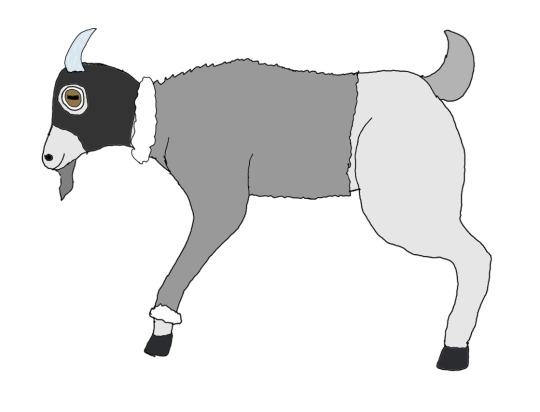
Tahrkid evolves to Yodhatahr, the Ice Horn Pokemon, ice/fighting type. Their horns are made from nearly indestructible ice, allowing them to pulverize boulders with a single headbutt. When two fight, the slam their horns together until one's horns break or it submits.
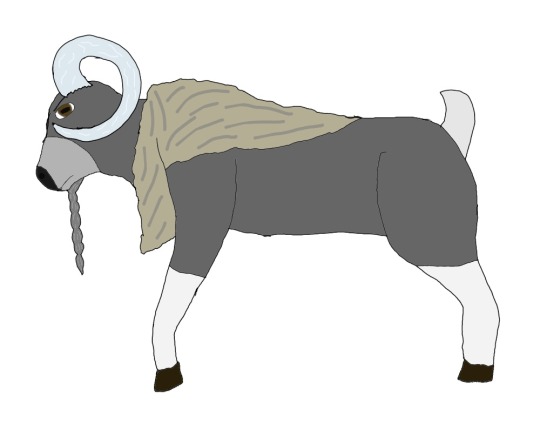
Tahrkid and Yodhatahr are based on a combination of mountain goats and the Himalayan tahr, a species of wild goat found in the Himalayas. Yodhatahr also has ram horns and Tahrkid appears to be wearing a coat and ski mask. Tahrs are an invasive species in NZ, where they can outcompete local herbivores in the mountains. The line's ability to climb nearly vertical surfaces is something real goats do and real goats also headbutt when fighting. Tahrkid's name comes from "tahr" and "kid" (juvenile goat) while Yodhatahr's name comes from "tahr" and "Yōd'dhā", the Nepalese word for "warrior". Presumably this line would originate from the Pokemon world's Himalayas and would therefore be known in the Pokemon version of Nepal.
The final line for this post starts with Dimpole, the Ball Pokemon, poison-type. Dimpole were introduced to Goorda from another region and have become an invasive species. They bounce and roll on their spherical bodies in such numbers that they coat the land during breeding season, causing a trip hazard for humans. They enjoy bouncing and being sent flying, so humans will hit them with sticks and golf clubs to get them out of the way.

Dimpole evolves to Foretitoad, the Toad Pokemon, poison-type. Foretitoad are an invasive species in Goorda. They leak toxins wherever they go, allowing them to reduce fertile fields to bare ground, while also making them too toxic for predators to eat. Females have spikes on their backs that they use to carry their eggs. When the young hatch, they use their paddle-shaped tails to send the young flying into new habitats.
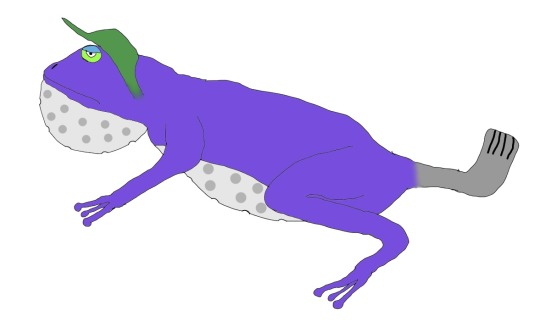
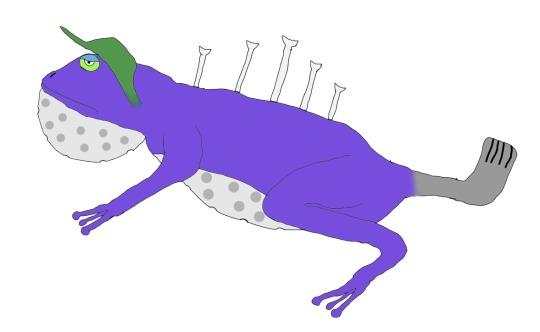
(Male on left and female on right)
The Dimpole line are based on cane toads and toad golf. Cane toads may be the most notorious invasive species in Australia. Because of how many there are, people have invented various ways to kill them, the most infamous being toad golf: hitting them with gold clubsPart of the reason cane toads are so invasive is because they're too poisonous for most native species to eat. Dimpole is tadpole merged with a golf ball while Foretitoad is a toad with a golf ball belly and throat bouch, gold visor shaped head crest, golf club shaped tail. and the females have spines shaped like golf tees. Also their eyes look like the logo of Golf Australia. Golf is also not originally from Australia and, like cane toads, is terrible for the environment. Dimpole come from "dimple" and "tadpole" while Foretitoad comes from "fore", "fortitude", and "toad". @reikomania helped me come up with the design for this line.
#pokemon#fakemon#original pokemon#australia#new zealand#aotearoa#gorse#old man's beard#spriggan#mountain goats#himalayan tahr#tahr#cane toad#tadpole#golf#golf ball#art#new artist#artists on tumblr#drawing#digital art
11 notes
·
View notes
Text
10 Reasons Patience is Needed in Planting Trees
Planting trees is one of the most rewarding activities for gardeners and landowners, providing benefits that last for generations. However, while the long-term rewards are immense, the process requires a significant amount of patience. Trees do not grow overnight, and several factors make patience an essential quality when it comes to tree planting. To help you start plating one, here are some of the reasons why patience is needed:
Growth Takes Time
Trees naturally grow at a slower pace than many other plants. Even with optimal care, it can take several years before a tree reaches its full size. Patience is needed to allow it to grow and mature, but with its results, you know it is worth it. It is also better to consider getting tree services Sydney for more professional advice and touch on your trees.
Seasonal Changes Impact Growth
Different seasons impact tree growth differently. Some trees grow more quickly in certain seasons, while others may go dormant in winter. Understanding this natural rhythm requires patience, especially if you want to plant different types of trees. This also applies to small plants and flowers, so consideration is needed.
Root Establishment
The first few years after planting are critical for root development. Roots take time to spread and establish themselves, which is essential for the tree’s stability and health. Rushing roots into growing can slowly damage the tree instead of helping it grow. Remember that without roots, trees will not grow high and healthy.
Nurturing Young Trees
Trees are not all about being high. There are also young trees that need attention because they are fragile and require extra care. Giving them time to adjust to their environment and slowly grow to their full potential demands patience. But even if you have enough patience and the tree is not growing to its full potential, getting the help of professionals might be what you need.
Pruning and Shaping Takes Time
Regular pruning is essential to shaping a healthy, well-formed tree. It is a slow process that requires repeated interventions to ensure the best structure. There are various pruning techniques you can follow to ensure the safety and proper growth of the tree. Doing wrong moves repeatedly can put your tree in danger in the process, ditching the entire idea of planting one
Patience Encourages Stronger Trees
When trees are rushed in their growth, they can become weak, poorly structured, or prone to disease. Allowing them time to grow naturally leads to a stronger, more resilient tree. If you want something long-lasting, this reason is enough.
Climate Adaptation
It can take time for trees to fully adapt to their new climate, especially if they are being planted in a new or different environment. This period of adaptation requires patience, considering that climate change is worsening each day and can be unpredictable.
Pest and Disease Resistance Takes Time to Develop
As trees mature, they develop natural defences against pests and diseases. However, this process can take years, and patience is needed to protect them during the early stages of life. If you see pests, it is better to have professionals involved in removing them to ensure that every step and process will be done correctly. The following are some pests you might encounter in your trees, no matter how old they are:
Brown root rot
Cankers
Cigarette beetle
Cup moths
Erinose mites
Giant wood moth
Leaf beetles
Scarab beetles
Termites
Ecosystem Contribution Takes Time
The ecological benefits of trees, such as carbon sequestration, improving air quality, and providing habitats, take years to develop. Patience is necessary to see the environmental impact of planting trees.
Tree Canopy Development Takes Years
A full, dense canopy does not happen overnight. It can take many years for a tree to reach the height and spread required for a complete canopy, which provides shade and shelter.
Here are more reasons to consider:
Building Soil Fertility
Trees Need Time to Mature Before Flowering or Fruiting
Water Requirements Adjust Over Time
Preventing Over-Watering or Over-Fertilising
Tree’s Lifespan Is Measured in Decades or Centuries
Tree Species Grow at Different Rates
Satisfaction Comes with Time
Planting trees is an investment that requires patience, but it is also one that offers immense rewards. By understanding the gradual nature of tree growth and the importance of care, you will help the tree thrive and ensure that future generations can enjoy its benefits. So, embrace the patience needed for tree planting— it is a gift that keeps on giving.
0 notes
Text
Dawn David: From Design to Deals
Dawn David: From Design to Deals https://ift.tt/3FYKGgL Real Estate Agent Magazine sat down with Dawn David, an associate broker at Corcoran with over two decades of expertise in New York real estate. REAM: What inspired you to become a real estate agent, and how did you get started in the industry? DD: I started my career working for Maurice Villency, a pioneer in the contemporary furniture field. While working at the company, I had the opportunity to decorate the house of a well-known celebrity from top to bottom. I achieved the single biggest sale in the company’s history. While working in design, I learned – and fell in love with – the world of high-end properties. Learning about the various design genres and property types made me realize how unlimited real estate careers could be. I transitioned into a sales career and knew I could bridge my skills from my design experience to benefit future clients. I started at Citi Habitats, focused on rentals, and quickly worked my way into an on-site Leasing Director Role overseeing lease-ups of multiple luxury properties. Then, I became a Sales Broker for new development projects. REAM: Can you tell us about some of the most memorable deals you’ve brokered in New York City? DD: Every deal has a unique story and challenges that require agility to overcome. Certain deals stand out for their adversity, but I’m just as proud of my new development sales as my rental deals because they are about the end-user and quality of life in their new homes. REAM: What strategies do you use to create value for your clients across different types of properties? DD: I aim to always provide a one-stop shop where clients can verbalize their needs and get an education on the market. I don’t want my clients to be stressed, so I go through a rigorous home prep process for listings and coordinate their moves. Following a consultation, I map out a strategy for each new client based on their property type, timeline, and goals. This is the fun part! REAM: What do you believe is the key to building and maintaining a loyal clientele in the competitive New York City real estate market? DD: Being proactive, confident, knowledgeable, honest, reliable, and trustworthy is vital, as well as always perfecting your follow-up. I encourage anyone interested in the industry to jump in the game as early as possible, be inquisitive, network, find mentorship, and never give up. REAM: What advice would you give to someone looking to start a career in New York City real estate? DD: There is no time like now to jump right in, seek mentorship, and take advantage of classes and networking opportunities. The odds will be in your favor if you do as much as possible to be visible, inquisitive, and open to new listings, partnerships, and collaborations. I also recommend telling everyone that you’re looking to get into real estate, and once you’re ‘in it’, hit the phones, emails, and hand out your cards in case anyone can refer business to you. You truly never know where the next lead can come from! REAM: What is something your colleagues would be surprised to learn about you? DD: Surprisingly, I am super-sensitive and have a genuine soft spot for the Senior Community! I also love connecting by phone; I am always open to picking up the phone, while many prefer texting. There is nothing like a good old-fashioned voice to get a sense of how someone is doing. REAM: Tell us a bit about yourself outside the office. DD: I love to travel and explore new restaurants. I also enjoy spending time in my garden, which I’m lucky to have in Brooklyn. There is something so therapeutic about planting beautiful flowers, tending to them, and watching them grow. It is so satisfying when someone compliments my flowers at a dinner party, and I can say that they’re ‘from the garden.’ via Real Estate Agent Magazine https://ift.tt/ojg7IhP July 08, 2024 at 06:56PM
0 notes
Text
After UN Biodiversity Conference: Let's Create Our Own Biodiversity
Last night, at a United Nations summit on biodiversity, called COP15, the majority of the world's nations signed a landmark agreement to protect 30 per cent of the worlds landmass and oceans by 2030. This comes at a time when one million of the roughly eight million known species in the world is threatened by extinction, a rate never seen before in human history. In spite of its sweeping success of reaching an agreement in the first place, there has been considerable criticism whether the goals are realistic to achieve in such a short time frame, or regarding the financial and economic details to implement such a decision.

image source
What Does It All Mean?
Now you may be jumping of joy that world leaders are actually coming together to save us from ecological disaster, or you may be more cynical, pointing at the myriad of previous such agreements, that were signed but later abandoned, modified, or simply turned out to be less effective than intended. If you ask me, all this doesn't matter too much. It's way more important what each of us does, in our own lives, to help biodiversity. The solutions are in fact ridiculously simple, but here I want to list a few of them again, just in case:
Don't Mow, Don't Rake, or if you must, Don't Do It Everywhere!
Okay, this goes for all those who have conventional lawns and park-like empty areas under their trees. Sure, you may enjoy seeing an expanse of short cropped grass, much like a soccer field or golf course, in front of your home. But is it really THAT necessary? Please keep in mind that not only does your lawn have its own maintenance costs, but it is actually more like a desert for any birds, insects, let alone the multitudes of soil dwelling species, who simply can't find a place to live there. The same goes for the Autumn chores of raking up all the leaves to burn them, or bag them up for someone else to do it. Those leaves would have done amazing work for the soil, starting with protecting it from the frost, providing shelter for creatures, all the way up to turning into nutritious topsoil.
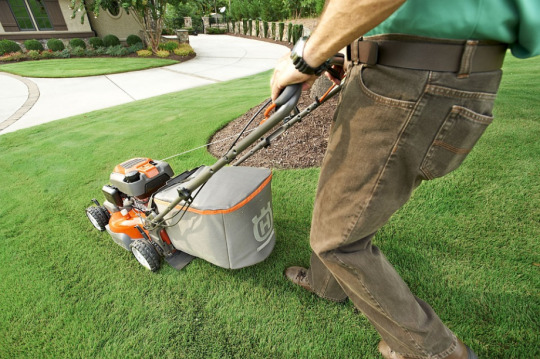
image source
I'm not saying you shouldn't have a lawn at all, after all it is nice to have a grassy area to kick the ball around. But leaving a few unmowed islands here and there, even tucked away in corners or behind bushes, will make a huge difference for local species. You will see this right away with the increase of butterflies, just by leaving a bit of space where their favorite plants can grow. As for the leaves, again, it's okay if you want to have some leafless areas. But keeping some areas covered with leaves, especially around trees, is bound to make your place more alive with creatures of various types.
Plant Natives in and Around Your Garden!
There is a good reason why certain species are native to an area: they've evolved together with the place and each other, to maintain ecological balance. Each of them has their own series of contributions, which could fill books on each of them. Of course it is best to become familiar with native species, if we are occupying their space after all, but what's more important is letting them thrive and just do their thing. By doing so you will ultimately invite other native species to live with what they are most familiar with.

image source
This can start as small as a garden bed. Wild flowers and other "weeds" will bring in pollinators that the rest of your garden will also benefit from. These in turn bring in their predators, who will most probably also decimate your "pests" a bit. So everyone will benefit. If you want, you can extend it to bushes or even native tree species. If you go out to your local wilderness, you'll be able to observe these plants in their own habitat, check out who they love to team up with, so you can design your native area accordingly. Or, you could just lean back and let nature take its course. The result should be pretty similar.
Build a Pond!
One of the most certain ways to invite many different creatures to your place is by offering them the one most important thing in life: water! We're all made of water, so this constitutes a need that perhaps surpasses all others. No matter if you're an insect, a bird, a mammal, or a plant, you will need to drink. For this reason, a pond is bound to bring everyone together who gets thirsty, and then some. So building a pond is a great idea. Just make sure to keep some things in mind:

Give good access to all creatures, big and small! Some need a steeper shore, others require a very shallow one. Some prefer to hide between reeds or other plants, others like a sandy beach, still others love to hide between pebbles or sun themselves on larger rocks. Your pond should cater to all!
Make sure the size is right. In the winter you don't want all the water to turn to ice, so having a large volume with a good depth is essential. In the summer evaporation can be an issue, so having a shady part is also pretty important.
Many species will come at free will, but others need to be brought in. There is always a chance that a remote pond in the desert will have fish in it some day... but it's way easier to just introduce them. Make sure they are the right type who will appreciate your pond, and once they've started reproducing, as well as being eaten by others, you can proudly claim you've created fish habitat.
Give good access to all creatures, big and small! Some need a steeper shore, others require a very shallow one. Some prefer to hide between reeds or other plants, others like a sandy beach, still others love to hide between pebbles or sun themselves on larger rocks. Your pond should cater to all!
Make sure the size is right. In the winter you don't want all the water to turn to ice, so having a large volume with a good depth is essential. In the summer evaporation can be an issue, so having a shady part is also pretty important.
Many species will come at free will, but others need to be brought in. There is always a chance that a remote pond in the desert will have fish in it some day... but it's way easier to just introduce them. Make sure they are the right type who will appreciate your pond, and once they've started reproducing, as well as being eaten by others, you can proudly claim you've created fish habitat.
Be Your Own Biodiversity Resolution!
Whether you just leave a small "butterfly patch" in your otherwise close cropped lawn, or if you build a decent pond that migratory birds will start using as a pit-stop, you will have done your part in stepping up to counter our currently ongoing Great Extinction of the Anthropocene. In this case, you can really lean back and celebrate, because no matter what the actual outcome of the COP15 will be, local creatures will have a bit of a sanctuary in your place. And that deserves recognition!
Sources: 1, 2, 3
8 notes
·
View notes
Text
What Do Botanists Do On Saturday?
by Sarah C. Williams
Here in the section of Botany we’ve adapted in some strange ways, just like plants do, to the changes of the past year and a half. Let’s learn about the off days of some of our Super Scientists in the Section of Botany!
Mason Heberling, Assistant Curator of Botany
Collecting specimens has become a focus as more time was able to be spent in the field when we weren’t allowed to be at the museum. As our new Botany Hall entrance video shows, Assistant Curator of Botany, Mason Heberling and Collections Manager Bonnie Isaac collect plant specimens on a pretty regular basis. They also snag iNaturalist observations for these plants, taking photos that show what the plant and habitat looked before being picked and pressed.
Mason studies forest understory plants, in particular, introduced species and wildflowers in our changing environment. Mason has a bunch of fun projects going on this summer, ranging from coordinating seed collections of an uncommon native grass to send to Germany for a large greenhouse study to working with a team of students to study the effects of climate change and introduced shrubs on our forest wildflowers.
In addition to work in the field, the herbarium has been a busy place this summer too! Mason has been working with Alyssa McCormick, an undergraduate research intern from Chatham University, to examine stomata (the pores on leaves for air exchange for plants to “breathe”) and leaf nutrients in everyone’s favorite plant – poison ivy! Poison ivy has been previously shown to grow bigger and cause nastier skin rashes with increasing carbon dioxide in our air due to fossil fuel emissions. Alyssa is using specimens collected as long ago as the 1800s to examine long term changes in poison ivy.
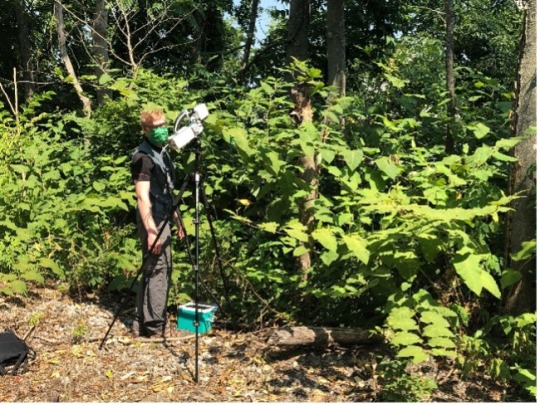
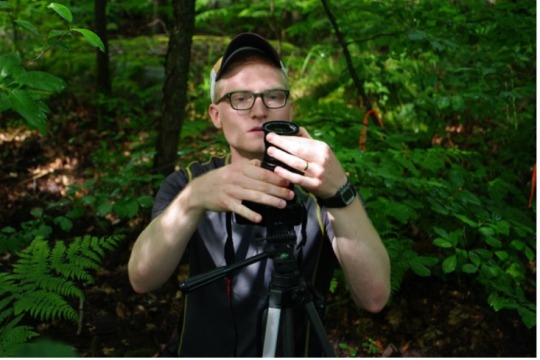
Mason, where can we find you on a Saturday?
“This summer has been a lot of going to various places around western PA like Presque Isle or Idlewild to get out and enjoy the fresh air with my family. I can also be found most Saturdays around the house doing chores!”
Bonnie Isaac, Collection Manager
Bonnie, one of CMNH’s TikTok celebrities, and All-Star in the Mid-Atlantic plant world, has spent a lot of the past year doing fieldwork. Her PA Wild Resource Grant involved looking at most of the populations for 10 Pennsylvania rare species. She and husband Joe Isaac spent many days on the road and a few in the bog! You can see some of her videos about these unique Pennsylvania finds on Carnegie Museum of Natural History’s Tiktok account: @carnegiemnh.
She diligently keeps track of various data points from latitude and longitude and elevation, to flower color, size, and associated species within a habitat. In addition to trying to make sure the plant names in our database are correct, she has also been busy georeferencing some of our specimens so that we can see on a map where each one was collected.
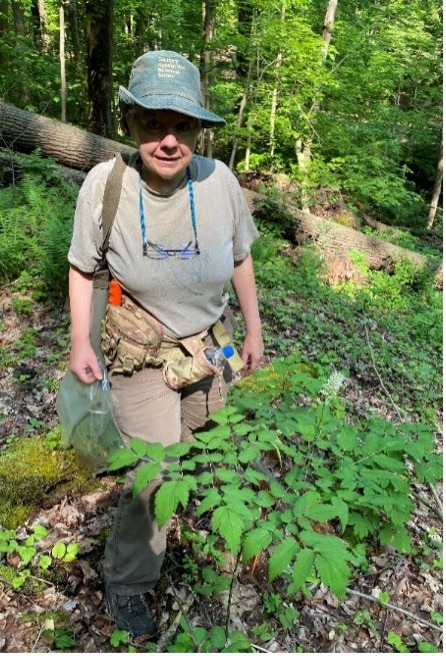
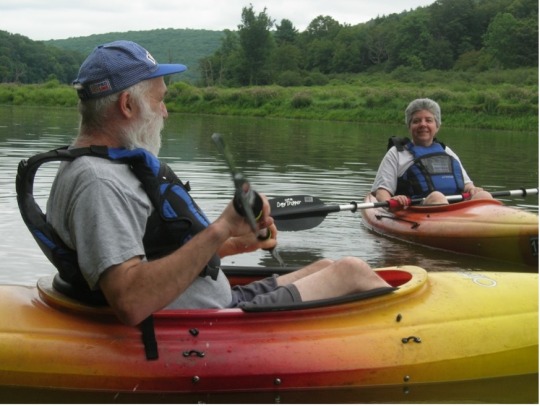
Bonnie, where can we find you on a Saturday?
“On most Saturdays I am either home taking care of my many chickens or getting some exercise in one of my kayaks with my spousal unit, Joe. I sometime even take a fishing pole for a ride or see how many different kinds of plants I can find on a hike. As long as I can get outside with Joe, I’m happy.”
Cynthia Pagesh, Herbarium Assistant
Specimens make their way home to the museum, where we assure they’re bone dry, flat as a pancake, and have been frozen twice to get rid of any pests. They then find their way into the nimble hands of Cynthia Pagesh, our resident plant mounter. Cynthia has luckily been able to do some mounting both onsite and at home over this past year, really honing her craft. She uses Elmer’s glue, dental and sculpture tools, linen tape, and a paintbrush akin to a magic wand: transforming roots, stems, flowers, and fruits into scientific and artistic renderings on an 11.5x16.5” archival herbarium sheet.
Mounting can be very detailed and challenging: wrangling a dry and brittle rare plant you want to salvage every detail from, or an oversized leaf ‘how-will-this-all-fit?’ ordeal, or finessing a delicate petal that glue is especially heavy on. Bulky bits, crumbly bits, spiky no nos: Cyn handles them all. Her work is just as much an art as it is a science. When she’s not making masterpieces, she’s probably doing something with plants.
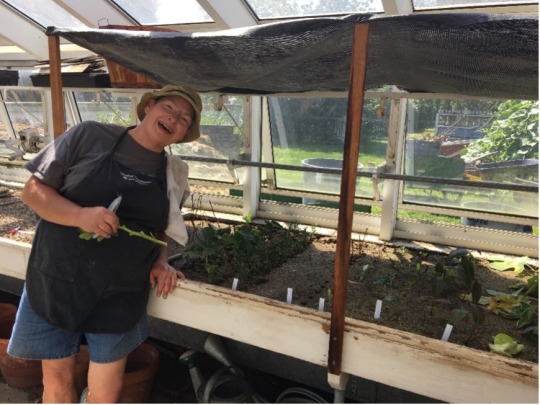
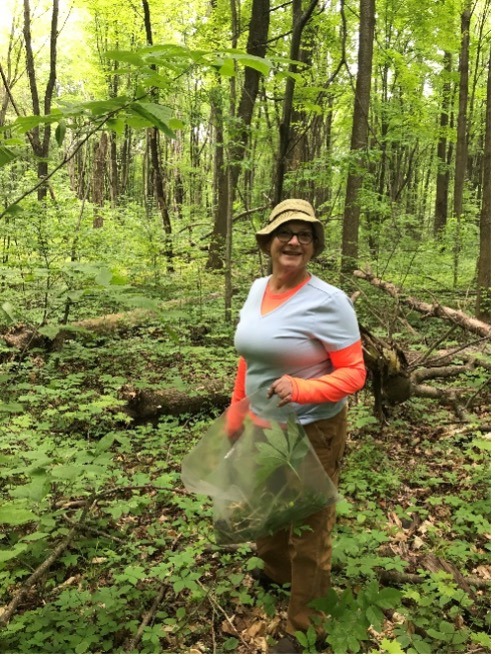
Cyn, where can we find you on a Saturday?
“You can find me on Saturdays helping prune young trees in my community, collecting wildflower seeds or in my kitchen making preserves or homemade pasta noodles. I volunteer in vegetable, herb and flower gardens. I have a pollinator garden at home and raise Monarch caterpillars. I tag and release them to migrate south.
There are lots of Community Science projects for people of all ages: ask someone to help you find one related to a subject you have an interest in. I have an interest in pollinators including bees. I participate in a Community Science Project every Summer that counts types of bees on certain plants when they bloom.”
Iliana DiNicola
After another stint in the freezer for bugs-be-gone, it’s everyone’s favorite day: Picture Day! Each plant: sturdy and mounted, all data logged and super official, makes their way to the imaging station to spend some time under the bright lights. Since 2018, students, interns, and volunteers have lovingly held these plants’ hands as they get their close ups. We take high definition photos using a specially made lightbox and special software.
While this is part of a limited project, called the Mid-Atlantic Megalopolis, we are still hard at work going into our last year of the time we were given. This past schoolyear and summer, former Pitt student, Iliana DiNicola was taking pictures for us on the regular while also interning with the Pittsburgh Parks Conservancy. She just graduated and I’m excited to hear what she does on her Saturdays in the future.
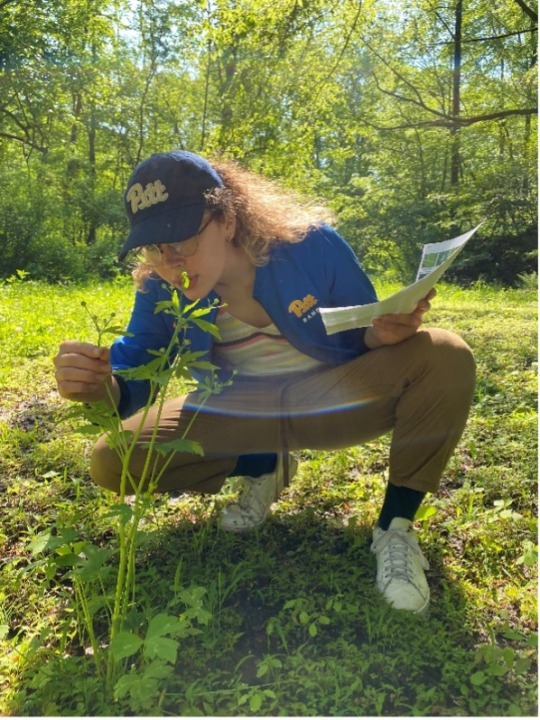
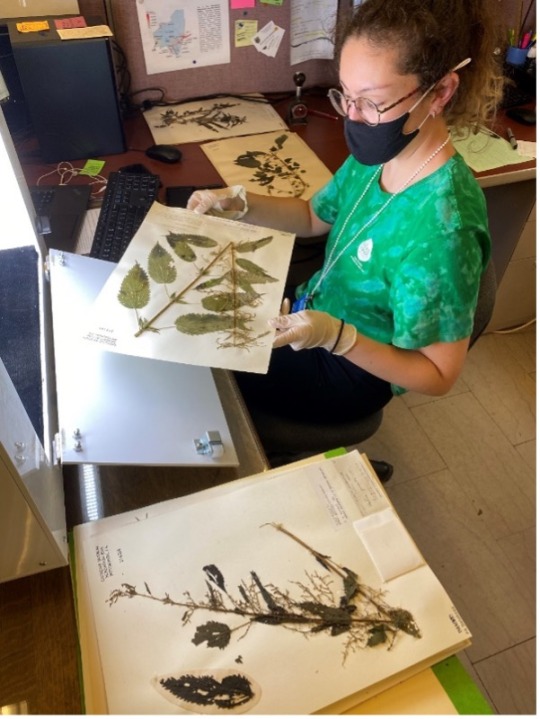
Iliana, where can we find you on a Saturday?
“I just graduated from the University of Pittsburgh with a degree in Environmental Studies, and I am now on the lookout for any jobs related to the environment back in my hometown of Phoenix, Arizona. I am interested in working with anything from sustainability, to policy or political work, or maybe even something more related to ecology and outdoor work.
On a Saturday, I am definitely helping clean my house since I am a semi-clean freak, I love to go hiking if the weather isn't too hot, enjoy drawing and working on any art projects, or work on my future hydroponics garden.
As somebody who interned for Pittsburgh Parks Conservancy, I highly recommend participating in any camps or activities the conservancy has to offer. It was super fun learning more about Pittsburgh's history and ecology and getting to teach kids about these topics, alongside participating in fun outdoor activities.”
Sarah Williams, Curatorial Assistant
Next up, Sarah Williams, the Curatorial Assistant in the Section of Botany, is overseeing the digitization project, morphing the photos from raw camera files into smaller files for sharing and detailed files for archival storing using Adobe Lightroom. She takes the images from the newly photographed specimens and makes sure they get uploaded onto the Mid-Atlantic Herbaria Consortium’s website to be shared far and wide across the world.
There is also a lot she does in sorting, filing, and taking care of the specimens as well. She does a bunch of scheduling, hiring, and training of work study students, interns, and volunteers. We consider her a jack of all trades.
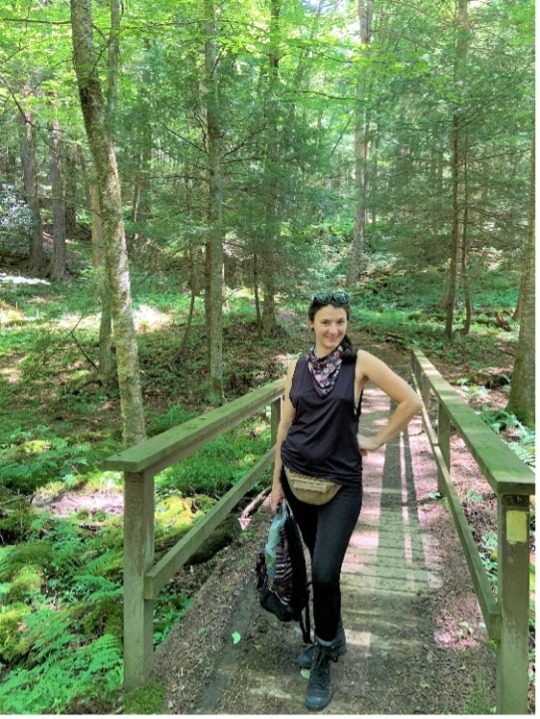
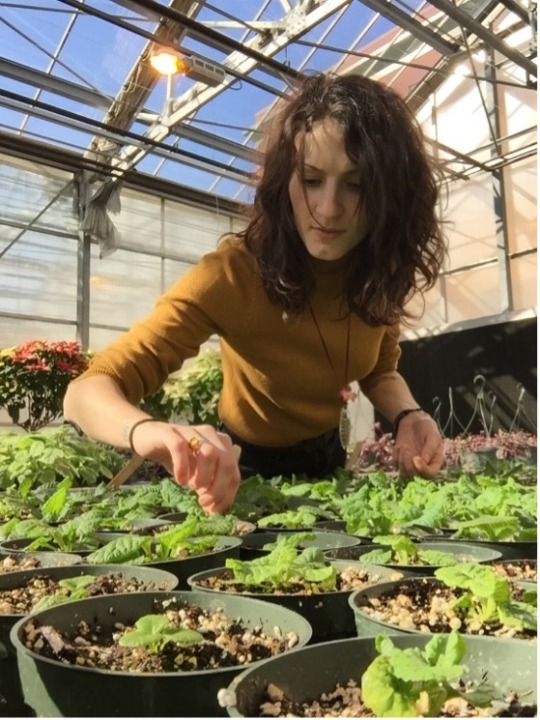
Sarah, where can we find you on a Saturday?
“Most weekends I work with a local catering company called Black Radish Kitchen. I usually end up serving delicious vegetable and farm focused meals at least one day a week, commonly Saturdays because they’re prime for celebrations. The re-start up since the pandemic has been cautious, and I’m excited to be amongst people and help them to make mouthwatering memories again. I’ve worked in the restaurant industry for over a decade and the skills I’ve learned doing it as well as the friends I’ve made are matchless. It has a big piece of my heart.
I also moved into a new house this year about five minutes from my mom, so if I’m not running to say hi to her and ‘borrow’ some groceries, I’m doing laundry, dusting and yardwork… but only after I sleep in, eat some delicious breakfast with my partner, and hang out with our two cats, Santi and Gil.”
We hope you enjoyed getting to know us here in the Section of Botany, look forward to updates and more introductions in the future as we continue to host volunteers, federal work-study students, and interns on their journeys to learn even more about the plant kingdom.
Sarah Williams is Curatorial Assistant in the Section of Botany at Carnegie Museum of Natural History. Museum employees are encouraged to blog about their unique experiences and knowledge gained from working at the museum.
#Carnegie Museum of Natural History#Botany#Scientists#Botanists#Herbarium#Natural History Museum#Museum Work
36 notes
·
View notes
Photo

To put it frankly, I found this exercise tough.
Even in writing this I'm really not sure why, to start with I thought it was an illogical way of thinking but I realised through some thought that it’s a way of considering all the factors that make up an issue or event. Furthermore, I remembered that this is how to analyse events in history and how important this way of thinking is for more than just that domain, it’s all the same way of thinking but labelled more appropriately.
but now, onto the main event:
1. What is the event/thing you have chosen?
The main premise is that people like honey, which comes from bees. so, what do we do that influences the declining bee population?
2. Patterns - What are the patterns/habits associated with that event/thing?
Positive patterns:
more and more humans are aware of our adverse effect on nature around us and want to change people are going out of their way to alter their surroundings and actions to be eco-friendly (as evidenced by websites like: https://www.ranchandfarmproperties.com/blog/how-to-increase-your-local-bee-population) negative patterns:
people are the driving force in climate change which is altering the habitats of bees and other animals overpopulation of humans is stressing our food production, leading to deforestation to increase farming (among other reasons)
3. Structure - What has influenced the patterns?
laws have been made restricting the use of some chemicals in sprays that can either kill bees or weaken future generations.
As the human population continues to grow, we need more food to sustain it. This leads to a push for more land for agriculture and for that agriculture to be more” efficient”.
As an increasing number of humans live in an urban area, there is a greater desire to see their slice of it having a natural and healthy feel and so plants and wildlife thriving gives the desired effect.
4. Mind Models - What assumptions, attitudes, values and beliefs that underly the structure?
Most of humanity is striving to become more eco-friendly and a massive part of that is conservation of environment and species so it is an easy step to try to mitigate the impact we are having from small things like changing what soap we use to using biodegradable plastics in shipping all around the world.
however, the issues that come up immediately are staggering, some examples are as follows:
3rd world countries find it harder as they just don’t have as many resources as more developed nations and need to put the needs of their citizens first. climate change is often felt hardest in these countries as they cannot combat it as effectively, (e.g.) creating droughts, leading to a lack of food and access to fresh water which impacts both humans and wildlife. Large companies exist to make money and becoming more eco-friendly affects their profit margin. An infamous example of this is Nestle, they consistently use a staggering amount of water every year, in some cases this even deprives people of clean water to drink or wash in. While it does seem like an overwhelming prospect, a key to staying positive and on the right track is looking for the people making a difference.
Treaties between countries like the Paris agreement signed in 2016 lay out a set of guidelines and targets to aim for but its people like Greta Thunberg and Felix Finkbeiner that help keep the issue in our eyes while also setting up organisations to plant trees or protect various wildlife. counties are using tourism to make it clear to more people worldwide that the climate is changing and not for the better. some are even taking more polarizing steps like legalising heavily controlled trophy hunting to funnel more funds into conservation efforts whilst also providing a boon to the surrounding communities. While Bees and honey were the start of this, the bigger message is humanity taking more than we give back. However, we are slowly turning in the right direction and its better late than never.
here are some websites I used form some research:
https://www.ranchandfarmproperties.com/blog/how-to-increase-your-local-bee-population https://bit.ly/3rsbxtA https://ourworldindata.org/land-use#total-agricultural-land-use https://www.un.org/press/en/2019/gaef3516.doc.htm https://bit.ly/2Oac19e https://wwf.panda.org/discover/our_focus/wildlife_practice/species_news/wwf_and_trophy_hunting/
4 notes
·
View notes
Text
OCs their symbolic flowers and the Hoepian floral equivalent
Dusting off old brain notes, cause of a time I’d include/place a “symbolic flower“ for every OC just cause.
Terra- Tiger Lily
“ these flowers are representative of pride. ”
“this particular lily is more often associated with the more aggressive feminine characteristics.“ [x]
While the first line actually works for Terra well (she does hold fondness for her own hard work) I’m pretty sure I chose Tiger Lily for her cause of the latter line way back- though one could very strongly argue Terra might not fit the bill of Aggressive Femininity (idk what that’d even be visually) I’m pretty sure I took the line literally at the time as “a woman who’s strong/aggressive“.
Outside of that I probably chose Tiger Lily cause the orange/black pattern of the flowers match with Terra’s red/black clothes.
“The Tiger Lily is said to mean "I dare you to love me"“ [x] Terra is not really one after romance, yet this feels very weirdly Terra-esque.
Hoepian Tiger Lily (Lilium flareonsis)
“Evolved from the Earth Tiger Lily (Lilium tigrinum), the physical differences between the two are surprisingly few. Found in open woodlands, fields and meadows, it absorbs the sun's rays and converts them into flame magic which is stored in it's bulbs. The flame magic makes the bulbs rather spicy, hence they are a very delicious (but common) delicacy. They are also used to start campfires and bonfires. Although harmless alone, they can be potentially dangerous when growing near the magically impressionable Soul Daisy.” [x]
One of the few species of Hoepian flora to not diverge much from its Earth ancestors (two of the others being Ginkgo macrophylla and Ginkgo triloba from Earth’s Ginkgo biloba). They have a huge morphological similarities with Lilium tigirium and Lilium superbum, but the petal patterns are very different; black spots towards the center alike to L. tigirium but also have stripes widthways nearer to the ends of the petals (a characteristic not at all like any Earth lily species). Also like most Hoepian flora, Hoepian Tiger Lilies do not have green foliage, and instead have red foliage.
Kayla- Daisy
"Daisies symbolize innocence and purity.” [x]
Being that Kayla is considered one of the more innocent and purer characters (at least to a degree) this is not a huge surprise this flower ended up being her flower.
Soul Daisy (Magiflora australis, M. borealis)
[My old excepts on this flower is a bit hefty so let’s make it shorter-] Soul Daisy flowers/seeds are harvested for purified magic- so is often grown agriculturally for mana-based industries. Being the magic in question is in its purest form, it changes/meshes to whatever element/magic that’s in its presence (ex- a breeze could become a strong wind gust due to the magic making Wind Magic) making it potentially hazardous if one is late to harvest fields of this plant.
While an agricultural crop it is not entirely domesticated; the outer edges of Soul Daisy fields develop needles to make a protective barrier in the masses from herbivores.
The flowers look very similar to Earth daisies; a pinwheel of long white petals with a faint blue/cyan stripe that makes a ring when all the petals are together on the flower. If altered by magic Soul Daisy flowers change colour to closely resemble the magic they are changed to. All but 4 of the petals are rounded, the said 4 are spit on the ends, making a mild resemblance to a cross.The stems are black on older growth, while younger growth is a vibrant pink. The leaves are violet in colour and look like rounded fern fronds.
Despite the name “Soul Daisy“ there is not much spirituality involved for this flower when it comes to Hoepian culture. It may be named so cause of the cross pattern, or cause of it producing the purest form of organic magic (like the “soul of magic”).
Unlike Earth Daisies, Soul Daisies also have the symbolism of impressionablility due to the pure magic that so easily changes to the elements around it.
Harriet - Sunflower
“Many groups associate sunflowers with prolonged constancy and loyalty,“
“Various faiths have adopted sunflowers to express a symbol of worship and faithfulness, as in the flower’s faithful dedication to the sun.“ [x]
Harriet is very loyal and ride-or-die for her friends so the former goes without saying. Harriet can be very idolistic towards very beautiful women (like Riivar) so worship might be a lil on the nose. I actually chose Sunflowers for Harriet cause of her sunny attention-seeking disposition, akin to the bright attention grabbing sunflower.
Water Sunflower (Haquanthus volitariflora)
While descended from Earth Asteraceae, this plant has adapted to the ocean and looks like a blend of sunflower and kelp. Sparse in rich sunny aquatic groves, but are in larger thickets/forests (of its own species) in colder/sparser waters. They are grown in some coastal settlements as the oil rich seeds are a food source. They are also a favoured snack for amphibious animals.
While the roots are anchored to the rocks, the leaves and even the flowerheads are full of air to keep the rest of the plant afloat. The large flowers are very resembling of Earth’s Mammoth Sunflowers.
The flower/seedheads are large and full enough of air to hold a small person afloat, though it would be a very bad raft alternative.
Riivar- Forget Me Not
“Forget-me-nots represent long lasting connections that can exist between not only lovers, but also friends. This connection can’t be broken or shaken by anything or anyone.“ [x]
Back in her child/teenhood she was head-over-heels in love with Terra, who was Riivar’s first love too. It didn’t work out but she still holds a tenderness for Terra and will not forget that first love.
Memberance Tree (Neomyosotis flexilis)
“A tree descended from the annual Forget-Me-Not plant (Myosotis spp.). They are sexually dimorphic flora; the female plants/flowers stay short and small like their Myosotis ancestors, while the male plants grow into gigantic willow-like trees, which spread their pollen around through the wind. Also like their ancestors they are most commonly found closeby waterways and marshes. On Hoep they have similar symbolism to the Earth Forget-me-not.“ [x]
The stems/wood are a deep purple while the leaves are a dark pink. The flowers are identical to Earth Forget Me Nots.
Riivar has a large tattoo on her back that’s a broken heart surrounded by Memberence tree flowers. It’s multiple layers of symbolic; it represents her first love (Terra) but also represents her remembering her roots she left behind. The broken heart has an additional meaning; her stepping down from her royal heritage.
Demauria- Venus Fly Trap
Sadly could not find an applicable symbolism; I don’t even remember why I chose Venus Fly Trap for Demauria (a more ice/cold thematic flower would’ve perhaps been a better choice). Perhaps I wanted a ferocious plant for a ferocious personality. I may change this if I ever find a better flower to represent her.
Gator Jaws (Lagartofolia dentislux)
“A carnivorous wetlands species that is found in abundance in the country of Swamani, and in lesser frequency outside the country’s borders. They are quite common in unlit rural areas and rarer near urban areas especially if the cities are illuminated at night. It is a plant that has adapted to attract insects for nutrition at night by illuminating it’s “jaws” during dark hours. Light illuminates on the tips of the “teeth” of the modified leaves as well as inside in leaves itself. Like the Venus Fly Trap which it evolved from, it has hairs inside it’s jaws to help detect and trigger the mouth to close and digest its prey while inside. Also like it’s ancestor, it flowers infrequently and younger specimens tend to die after flowering. The foliage colour of Gator Jaws can range from red/purple to green/orange, and it is not uncommon to find an entire range of different coloured specimens in one area.
There isn’t much agricultural or herbal significance for this plant, however it is still commonly used in Swamani to edge along and illuminate major roads and routes so that the paths can be easily seen and used at night. The macrophylla form of the plant is most commonly used for such paths, and is rarely seen anywhere else compared to other Lagartofolia forms.
In some places Lagartofolia is also known as Growlroot, named so for the growling sound that emanates from the roots of the plant when stepped on. The growling is caused by air pockets among the roots which are released out of the ground when the roots are compressed. It is unknown if these air pockets among the roots are an adaption to give the roots oxygen in watery habitats or if they exist to makes the growling sound as an attempt to scare off potential grazers of the plant.”
They greatly resemble Venus Fly Traps, except that the “trap“ is longer and resemble a crocodillian’s mouth, and the “teeth/hairs“ have bioluminescent bulbous tips.
Anne- Protea
“Diversity – The Protea flower is certainly different and it stands out from the crowd. This unusual flower is attracting attention no matter how beautiful the other flowers next to it are. There is simply something beautiful and mysterious about its appearance and it is a perfect gift for someone equally unique.“
“Courage – Gifting someone the Protea flower is also a symbol of courage. This flower symbolizes overcoming obstacles and finding courage inside of you to make a difference in the world. This flower has a very strong message“
Admittedly not unlike Demauria’s flower, Anne’s was also on a mildly mysterious whim. Unlike Demauria’s though, Proteas do have some symbolism attached to them, which also could be applied to Anne. She does indeed stand out from the crowd (though she may not want to), and the courage works as she throughout the story has to get the courage to open up to others as well as to face the Fallen Slayer destiny/responsibility which she is very scared to face.
Molten Protea [new af so no botanical name]
I still haven’t made up much for information/ideas on this Hoepian equivalent. Just that simply it grows exlusively in hot volcanic habitats (lava flows, volcanos, and in rare cases hot geysers). Probably has a visual molten motif similar to lava/magma. Probably blooms or goes to seed after events like volcanic eruptions.
#wait- I actually got it all written down in one session??? well dang hooray#oc ramblings#wall of text#hoepian flora#ramblings
2 notes
·
View notes
Text
Permaculture Design Course
We dialled in from living rooms, bedrooms, caravans and gardens across 11 different time zones, from Abu Dhabi to California (with Brazil and Berlin somewhere in between). Our reasons for being here were all unique and yet all similar; concerns for the future; for the mass extinction event and loss of natural habitats; hoping to learn how to live sustainably; how to grow food naturally; how to produce more than we consume; how to change career; how to live without doing harm; and how to co-create a better world for our children and future generations to grow up in. In the context of one of the biggest worldwide pandemics in living history, this group of strangers met in the timeless hinterland of the online meeting room to explore, share, and learn about positive solutions both now and for our futures...
I stumbled across The Permaculture Design Course quite by accident (as I was looking for ways to make my struggling garden thrive rather than merely survive) but, over the course of a month, this unexpected experience changed my life completely... For the first time in 35 years I feel that I have been given access to a toolkit for living - a set of frameworks, processes and principles which speak entirely to what I feel and know to be real and right - for how to be and live in the world in deeply connected, holistic and sustainable ways... At a moment when I was feeling incredibly helpless and overwhelmed by global and personal circumstances, the PDC and this group of wonderful, disparate strangers, appeared “as if by magic” and turned around the whole way I understand myself, my power, and my place in the world. On my ‘rewriting trauma’ journey the PDC has been an invaluable turning point and has provided me with the maps and materials I most need (though may not have been looking for) for going forwards...
Since finishing the course I have been asked numerous times by friends, family and neighbours “What IS Permaculture, exactly...?” And I have responded with numerous answers (according to who was asking, their reasons for asking and the context in which the question was asked) but I would like to take this opportunity to address that question, in the best way I know how, through the precious and manifold ideas and conversations which came up throughout the course. I want to respond to the question “What is Permaculture?” in this way (rather than offer a singular narrative) because I believe this embodies and reflects much more of the essence of what Permaculture is : a set of principles, processes and frameworks for living which can be tailored to the particular and specific answers and solutions each one of us seeks in our own, unique context.
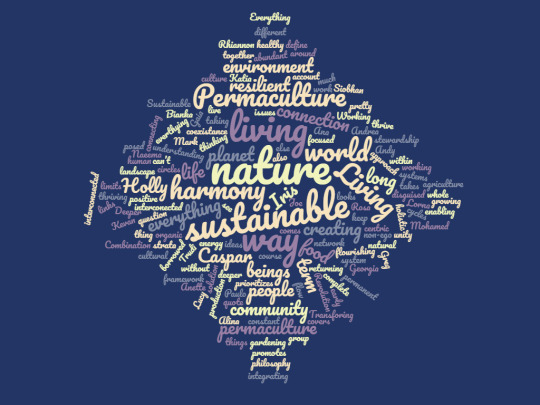
Word bubble formed from the PDC reactions to the question “How do you define Permaculture?” 2nd June 2020
“You can’t have sustainable food production without sustainable everything else.”
Graham Bell, Online PDC, June 2020
June 2020 was an astonishing and deeply challenging month in so many ways… Personally, I was forced to face the vulnerability of my own situation; my reliance on shop bought food and uncertain income streams when, at the very outset of lockdown, literally all of my work dried up, my partner was made redundant and access to food was scarce and difficult. Then there was worse to come. In the late hours of the 16th of June, my cousin Beth died. The news arrived during one of our PDC sessions. She had been battling secondary and primary breast cancer. This is a heartbreak and a loss I am still trying to understand and process (but one which, had I not been held by this group and this experience, would have been so much harder to deal with).
Meanwhile, on the international stage, people were facing so many additional threats and challenges posed by the Coronavirus Pandemic. The death statistics highlighted the social and economic inequalities, both at home and abroad, particularly along lines of race - with a disproportionate number of deaths and redundancies in people from BBIPOC (Black, Brown, Indigenous, People of Colour) backgrounds. We saw deaths in refugee camps sky rocketing. These statistics were a bitter salt in the wounds of exhaustive and institutional racism which we saw enacted again and again from the refugee crisis in Syria and Yemen to the police murders of George Floyd in Texas, Israel Berry in Oregon, Tracy Downe in Florida and many more besides… Some of us white folx, in waking up to the scale and pervasiveness of institutional and embedded violence towards our African, Asian and South East Asian Diaspora friends, that we (I) started to understand our (my) own white fragility and the systems of dis/advantage which many of us have been complicit in. And it was amidst this context of great uncertainty and upheaval that the PDC took place...
Over the course of the month of June, with three day-long zoom meetings a week and a handful of break out/additional sessions in between, we explored (amongst many things); the ideas and inspirations behind Permaculture; the centrality of Observation; Non Violent Communication; Patterns; Input & Output Analysis; Wild Design; Trees and Soil; Guilds - what they are, how they work, making our own; Arts and Culture(s); Landscape; Climate; Planning for the future; Alternative Exchange Economies; Food and Water; Six Coloured Thinking Hats; Plant Families and Nomenclature; Sociocracy; Healing; Cooperation vs Competition; Zones and Sectors; Needs, Wants and Offers… And many more things besides and between.
Though I was not aware of it at the time (though I might have been, had I read the curriculum and course handbook in advance!) almost the entire first half of the PDC was taken up with the co-creation of a safe and productive learning space and culture.
One of the first questions posed to the participants was from Kate Everett who asked “What makes learning work for you?”
I struggled to identify what had worked for me in the past but could instantly conjure what made learning not work: I thought of GCSE revision, 20 cups of tea a day, desperately cramming information into my head… I thought back to how long it had taken me to learn how to tie shoe laces or to put up a tent because of how much heat and anger there was from my father and his father that I couldn’t just do it… I thought of those feelings of shame, humiliation, stress and of shutting down when I was told I was an idiot and a failure… But then, interestingly, so many others in the group articulated similar experiences - “stress, school, competition”…Some people described themselves as lone wolves, others learnt better in groups, some benefited from working together over a problem or by sharing what they were learning… But what all of us agreed upon was the inhibiting effects of stress on learning and the need to enfold experimentation, play, overview and failure in order to make our learning journeys productive and engaging...
“Learning is love”
Graham Bell
Little did we know it at the time but all this information about our individual learning experiences was being observed, gathered and harvested… as we learnt about ourselves and one another we were also learning how to create the best learning (and hence growing) conditions for us as individuals and as a collective. Though we may not have fully realised it as it was happening, we are all in the “inverted classroom” : we had all become the teachers, as well as the students and would learn more from the collective than any single teacher or pedagogy could ever bestow...
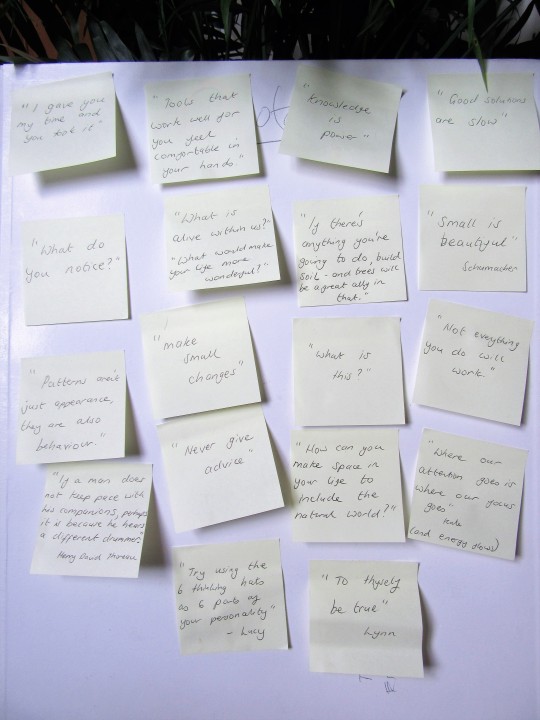
Quotes and prompts I collected throughout the course
“A person who doesn’t make a mistake probably doesn’t make anything”
Graham Bell
Mark Shiperlee introduced us to the concept of the Culture Board and we begin brain storming what factors are important to measure our course culture against. The factors we decided were of most importance to integrate into, and develop throughout, the course were;
Positive Solutions
Long & Short Breaks
Gift Economy
Time Keeping
Mutual Respect
Fun
Creativity
Task Setting & Reporting
Inclusion
Group Work
Connect With Nature
Throughout the course we would check in on the Culture Board regularly to determine what stage these various factors were at i.e. Seed; Sprout; Leaf; Flower; or Fruit. For me this was a valuable tool in understanding where the group felt our learning journey was at - which areas were working and which were not. It made this an easy, fluid and almost anonymised process and helped to address both the successes and the failures as we went along, understanding where energy needed focusing. This was one of many visual tools, along with The Life Ethics venn diagram, Six Thinking Hats, OBREDIMET, Looby’s Design Web, Input & Output Analysis, PMI (Plus, Minus, Interesting) Analysis, Importance/Urgency Matrix, and Relative Location which I have continued to use in my own Permaculture Life/Design Processes…
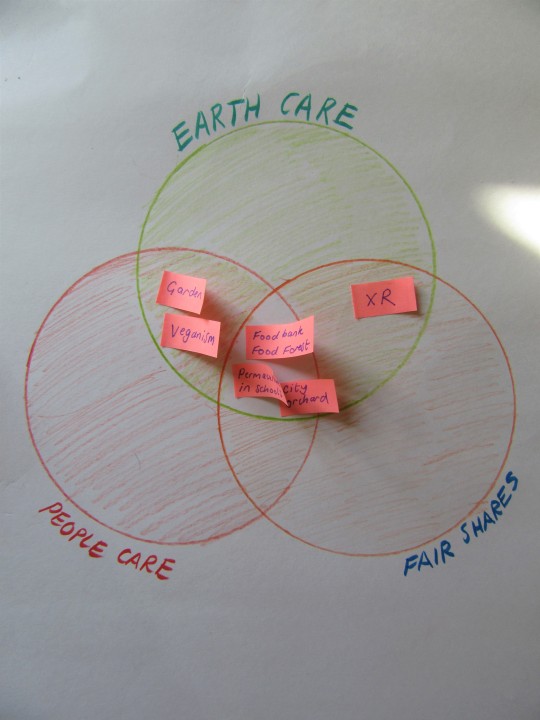
My LIfe Ethics Venn Diagram - i.e. the three main ethics of permaculture”Earth Care”, “People Care” and “Fair Shares” Where they all intersect is the core of Life Ethics
During the course we were also given our own break out Guild groups with whom we had to develop ad present a Permaculture Design Project with (below is ‘an artist’s impression’ of our Guild The Four Acorns - Lynn, Siobhan, Lucy and myself.
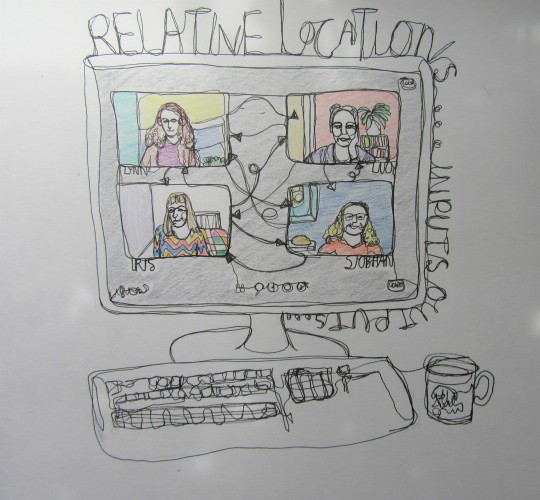
“Though the problems of the world are increasingly complex, the solutions remain embarrassingly simple”
Bill Mollison
By the third week of the course, with each one of our guild feeling exhausted by various life stresses (illness, work, family, bereavement, etc) we decided the best and most effective design we could work on was one for supporting each other as a guild whilst we embarked upon our permaculture journeys (the one thing which united all of us was that we wished to continue beyond the course).
We started applying some of the tools and processes we acquired throughout the course to our own visions for the future. We started off with Holmgren’s Permaculture Design Principles;
Principle 1. Observe & Interact
We began our guild process by gradually getting to know one another, developing & discussing project ideas that would tap into all of our needs & aspirations.
Principle 2.Catch & Store Energy
As we were all feeling a bit burnout we realised we needed to do something that would hold space and energy for us as individuals and a collective i.e. catch and store energy by making and holding space for one another. We wanted to encourage each other to feel safe enough to start exploring with new eyes and to assist each other’s courage in the face of major life changes.
Principle 3.Obtain a yield
We all wanted to carry on our development beyond the course and to share permaculture with others - so we asked the questions “How could we support one another in this?” But, in addition “What renewable resources and services did we have that we could use, share and apply?” and “What could we create - the main yield - within this guild?” We decided that the yield we could create in the present, but carrying into the future, was a space full of loving-support, inspiration, challenge and abundance.
Principle 4. Apply Self-regulation & accept feedback & Principle 5. Use & Value Renewable Resources and Services
As we began using permaculture tools to explore our individual designs, these processes enabled us to support and affirm one another; to share wisdom; tell stories; hear, value and integrate one another as individuals in a guild; become energised and strengthened by our diverse experiences, perspectives, knowledge(s), points of view; and to be challenged and strengthened by processes and making compassionate space for learning through failure too... And believe me, we did fail...
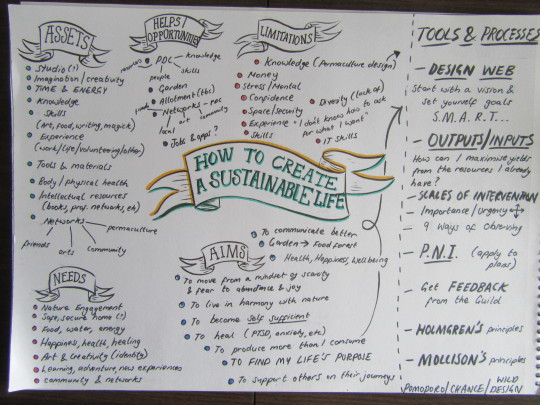
Mind Map at the outset of my own Permaculture Life Design exploring my assets, helps/opportunities, limitations, needs, aims and potential tools & processes to employ
“It takes shit... literal shit... but then you get humus”
Siobhan
On the last day of the course all of the individual guilds presented their design projects and it was amazing to see the wealth, depth and diversity of those ideas and the tools and processes (which we had been given throughout the course) put into action. There were design solutions that addressed; food scarcity; social isolation; mental health issues; segregation; alienation; loss of habitat and species; water shortages; poor health; access to education; job losses; seed sharing; community spaces; and so many more big issues. It was staggering.
In such a short space of time this small group of strangers had come together and, with the support of our guides and course leaders, co-created a network of support from across the world, positively enriching one another and the larger ecosystems each of us are a part of. It was a little island of paradise which cultivated an abundance of new perspectives, hope and courage. By showing us what might be possible and - rather than getting too mired in the negative/things we cannot control - looking to appreciate what we have, what we can be and what we can create together, the PDC taught us how diversity and collaboration can help us, both as individuals and a society, develop resilience in the face of the overwhelming challenges of our times.
It was an experience I will never forget and which I hope to keep alive as I go into the future (remembering to regularly use, sharpen and adapt those valuable tools)...
#permaculture#design#PDC#trauma#rewriting#collaboration#culture#diversity#solutions#growth#tools#futreproof#sustainability#food#growyourown#IrisPriest
2 notes
·
View notes
Text
Providing for Pollinators - my Syracuse Wildlife Garden
Hi everyone! Maybe you know me, I am a grad student with a B.S. in Wildlife & Conservation Biology and I study native bees. I am in New York for grad school and my landlady (I live in her personal home with one other PhD student) has agreed to let me turn part of her yard into pollinator habitat. I discussed this prospect a month ago here. On Memorial Day I got to work and finally planted everything!
I thought I would use this opportunity to share my ongoing experience and educate others about the importance and the feasibility of creating pollinator and wildlife habitat in your yard. Please, consider doing even just a little bit to help the natural world this year or in the future. Hopefully the information and resources I provide will be of use.
I will update this post throughout the season as the plants grow and bloom!
This first installment lays out the principles of habitat gardening and thus is pretty lengthy. Part 2 will talk about the plants I chose and include photos of the newly planted garden!
Wildlife habitat in the urban and suburban sphere is crucial going forward in the fight to save our planet from going belly-up. We think of ‘big ag’ as the enemies, and while that’s true, habitat destruction and fragmentation due to development has had just as large an impact, and we are all accountable. Pristine, untouched lawns, silent without birdsong or the buzzing of bees, has somehow become the ideal and a symbol of status and accomplishment (yet another way that western mindset of ‘man vs nature’ rears its ugly head). Few realize the harm that has done, and we’re at the tipping point now. But while we can’t overthrow Monsanto overnight, we can control our own little patch of earth. Reconnect the land, that’s the goal. You’ll find yourself reconnected to it too, in the process. And once you see the amount of thriving life you can support, you’ll never go back to that old turfgrass prison. Creating habitat is its own source of pride, especially knowing you will influence and inspire others to do the same.
There are infinite ways one could construct habitat on their property. It will obviously depend on time, money, desired use of yard (do you have kids? or barbecues? leave some grass), town ordinances, etc. I could have easily ripped up every ounce of turfgrass in the yard, but it’s best to start simple, especially when it’s someone else’s land! I have about a quarter acre to work with - which doesn’t seem like a lot until you realize just how many plants you could fit in there! More so, a quarter acre of habitat where there wasn’t any before sure makes a difference to the wildlife, especially bees, who often nest only a few meters from their host plants and will only travel as far as they need to for food.
Here’s an overview of the ‘before’:

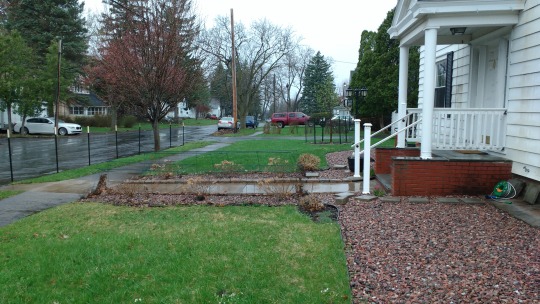
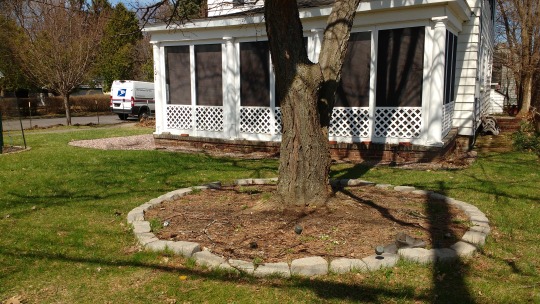

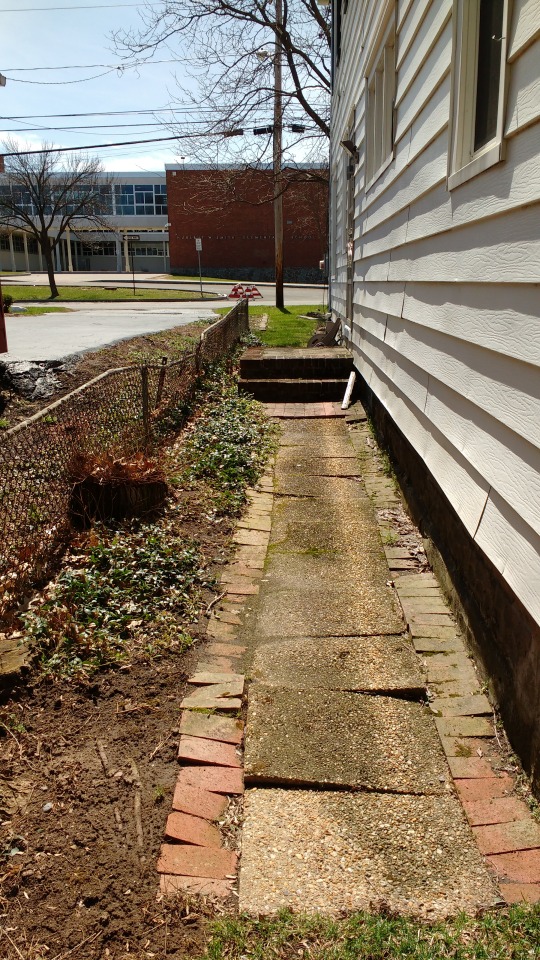
Basically, what we’ve got is a lot of turfgrass and some exotic ornamentals, with a few native trees scattered about at the boundary between the neighbor’s house. Existing plants were hydrangeas, hostas, hellebores, and vinca. I didn’t even know what vinca was (I am rather out of the loop with ornamental plants) so I looked it up, as it seemed very aggressive and had formed a dense mat over much of the ground along the borders of the property. Lo and behold, it is considered invasive in many places, yet it’s sold at pretty much every nursery. It has purple flowers that attract virtually no pollinators, and my landlady loves the darn thing so much she wants it to spread to cover the entire yard if possible. I’ve tried to steer her away from that... a big problem though, was that she did not have any idea what plants were in her yard. Apparently the landscapers did not tell her what they were planting, nor did she seek out the information herself, so I identified them all for her. Maybe it’s just me, but I could never rest not knowing what plants someone put into my ground that I’d have to live with for the next few decades. There’s a huge border of stones at the front of the house, apparently to stop flooding. Let it just be known that stones are pretty dang bad for wildlife habitat, as they do nothing but cover the ground and prevent things from growing. She wanted more stones, I steered her away from that also.
Principles of Habitat Gardening
Insects are good. Insects are what you want. Insects form the foundation of the food web for whatever animals you want to support. This means changing your mindset to see leaf damage as beneficial, something that traditional gardening has drilled into our heads as wrong and ugly. Songbirds rely on caterpillars to raise chicks, and pollinators help plants create fruit, seeds, and nuts, which countless animals rely on. Predatory insects like wasps, mantids, and many true bugs keep populations in check so no plants are ever eaten to fatal levels.
NATIVE PLANTS. How do you attract insects? You plant the things they eat, and that certainly isn’t ornamentals from Eurasia. Insects have long co-evolutionary relationships with specific plants, attuning their tolerance to certain plant defensive compounds. Most butterfly and moth caterpillars eat only a small range of plants, and over half of our bees in North America collect pollen from only one group of plants. These are specialists, and they form a crucial part of biodiversity that’s often left out when habitat is lost and urban sprawl leaves ornamental plants that only a few hardy troopers (the generalists) will tolerate. Native plants are not ~in~ when it comes to gardening though, and it is difficult to find them being sold unless you know where your local native nurseries are. Demanding these plants has slowly begun to change the market, and now some can be found as seeds in places like Home Depot or Lowe’s. Recent studies have shown that songbird nests can fail in suburban areas with a lack of native plants, due to low abundances of insects. If you want birds, once again, provide insects!
Native plants are easier to grow and care for than exotics, because they are adapted to your region, its seasons and climate and precipitation. That’s less manicuring, fertilizing, and pesticide-spraying on your part.
Remember what all animals need - food/water, shelter, and a place to raise young. Providing only one of these things doesn’t do a whole lot of good, as they may stay for a little while but not forever, and you’re not actually creating habitat.
Coarse woody debris - aka logs, stumps, snags, and brush piles - are very useful to wildlife, as sources of food (they host many insects), shelter, and nesting sites (a LOT of birds nest in tree holes and excavated cavities, as well as mammals). Leaving these ‘eyesores’ is doing a lot of good, as well as not raking your leaves (or at least keeping them in a pile) and allowing dead perennial stems to persist through the winter and spring. Bees will be nesting and hibernating inside them!! See? Less work for you, with a hefty payoff.
Diversify as much as you can, in every way you can. Bloom color, bloom time, plant family, leaf texture, growth habit. It will maximize the species you can host in one space.
The goal of creating habitat in your yard is bigger than just inviting pollinators and birds. It’s restoring connectivity to the landscape. Fragmentation of habitat has massive negative effects on wildlife, from mammals and amphibians who need to cross highways and go through yards to get to the next woodlot to the ‘edge effects’ of habitat islands surrounded by parking lots, loud noise, and urban predators. The more people create habitat, the more we ‘plug’ our land back into the larger landscape and help support wildlife at a much bigger scale.
Research, research, research! You need to find what plants are right for your state and region, your soil type and sun levels, and many other specifics only you know. Luckily, there’s plenty of information and books out there to help you (I will recommend some further down).
YOU CAN DO SOMETHING, NO MATTER HOW SMALL. You could own one acre or ten, or maybe just a windowsill or patio garden. Put out a bee hotel. Keep natives in pots (that’s what I do at home). Spread the word (that’s a biggie). You are always able to help.
So, for my situation, we have silty loam soil (you can find yours here), mostly full sun with areas of part-sun and shade. A big problem I had to plan around was the deer, who come through the neighborhood regularly and try to eat the hostas and hydrangeas. Many ornamentals are marketed as ‘deer-resistant’ but a lot of native plants are as well. It has to do mainly with leaf chemistry and texture which equates to some level of palatability. Of course, if they’re very hungry, deer will even eat pine needles. My landlady tasked me with creating habitat that was low maintenance. She is older in age and does not have the time or means to be manicuring everything. Apart from the deer resistance, my landlady also wanted a new groundcover that would thrive in full sun unlike the vinca, because her goal is less lawn to mow. I have a vendetta against the vinca now so I’ve vowed to do all I can do diversify the groundcover. There are many butterflies and moths that rely on various weedy or groundcover plants as caterpillar food (especially violets!). With these criteria, I set out to find a list of plants native to New York available near me for sale that would create a wonderfully diverse wildlife and pollinator garden.
Luckily, central New York has ample resources for this purpose. I utilized the Habitat Gardening in Central New York network heavily, as they have an annual complete buying guide for all native plants in the region being sold by participating nurseries. Audubon, Cornell Habitat Network, Cooperative Extension, Xerces Society, and many others also have information to help. If you’d like a bit of introductory and insightful reading, check this out. Native plants can be bought online as seeds or root stock as well, from places like Prairie Moon Nursery, which caters to the eastern U.S. There are many websites with information on specific plant growing needs, like the Missouri Botanical Garden site.
But wait, there’s more! Don’t forget about our best friend, books! Scientists have been working really hard to gather information and publish it for the public and in the last decade or so a really good handful of books about native landscaping, pollinators, and ecology have come out to aid the everyday person in creating habitat! I want to offer a list of some of my top picks, whether you just want to learn more about the topic or use it as a planning tool, these are pretty readily available at major bookstores.
Books on Pollinators, Ecology, and Native Gardening
#1 - MY ALL TIME FAVORITE!! MY GOSPEL!! Bringing Nature Home by Doug Tallamy (an esteemed professor at U of Delaware, I almost was his grad student). This gorgeous full-color book was the basis for a lot of what we have now and played a major role in introducing the public to the concept of native landscaping. It brought together concepts about the importance of insects, especially herbivorous ones, for birds and wildlife, why and how to support them, the reason we need native plants and why invasives are so harmful, and has a lot of resources and beautiful photos as well. You know how Christopher Lee would read Lord of the Rings every year? Yeah that’s me with this book. Everyone should own this.
#2 - The Bees in your Backyard by Joseph Wilson and Olivia Messinger Carril. This is the single best, most informative, well laid-out, usable bee book out there. Stunning portraits of every genus of bee in North America, with a section on their life history and a section (for us scientists!) on how to identify them under the microscope, thus it’s for all audiences. A significant portion of the book is devoted to the ecology and conservation of bees and how to create pollinator habitat.
#3 - Pollinators of Native Plants by Heather Holm. The book I’d write if it hadn’t already been written, this comprehensive book brings together an incredible amount of information and photos in a user-friendly format. It goes through wildflowers of the eastern U.S. from prairies to woods and wetlands, painting an in-depth picture of their ecological relationships with pollinators. Each plant has a profile about its life history and growing requirements, and the many pollinators that utilize it either as a nectar source or a host plant. Incredibly useful when planning habitat, and it has a huge section with a mind-blowing amount of charts and visuals to help you pinpoint exactly the plants right for your site and needs.
#4 - Buzz: The Nature and Necessity of Bees by Thor Hanson. A brand new book that I fell in love with as soon as I started reading it. Not a field guide; a book of science, conservation, and personal experiences told beautifully and full of passion. My favorite work of bee non-fiction! It is incredibly inspiring. It focuses on native bees, not honeybees (none of this work for pollinator gardens is really for honeybees, and there’s plenty of books out there on them if you’re more interested in that). Native bees are poorly known by the public, and this book endeavors to give us a glimpse into their world, from the evolutionary story that begins millions of years ago to the millions of alkali bees that have found a home on one Washington farm. You will come away wanting to start your new garden tomorrow.
#5 - Summer World by Bernd Heinrich. Well, ANYTHING by Bernd Heinrich. He’s a renowned scientist and naturalist from New England who has a heck of a lot of books documenting his observations and discoveries about the natural world over the decades, as well as the challenges it faces in today’s human world. This is one of my favorites. I’ve met him and I am constantly inspired and often brought to tears by his words. He weaves tales of science, history, and his own life together to match that of Thoreau or Frost and offer us insights into nature that we so often pass by in our hurried lives. Other books include Winter World, One Wild Bird at a Time, Life Everlasting: The Animal Way of Death, and The Homing Instinct.
#6 - Last Child in the Woods by Richard Louv. A groundbreaking classic that follows the principles of E.O.Wilson (one of the fathers of our field!!), that all human beings need nature to be healthy both physically, mentally, emotionally, and spiritually, and that we have an intrinsic connection to nature and a drive to have it in our lives. Our separation from it in the modern era has come at great cost to ourselves and the planet. This book sets the stage for serious research and justification for why children need to have contact with nature at an early age, how it affects our whole lives and morals as adults, and how it ultimately decides the fate of our world when those children grow up to either want to save the earth or contribute to its destruction. A fundamental and frankly, earth-shattering read. I read it when I was in high school, and it is so so important to the work I do now. Don’t get all ‘hurr durr Thomas Edison was a witch’ on me. You know we have a problem, and I see it every time a two year old is watching an ipad instead of what’s outside around them.
I hope these resources were helpful. If I think of more, I’ll add them in future installments. Thank you for reading, and I hope you will join me in tracking this garden through the year! I’m so excited :D
#nature#conservation#pollinators#pollinator garden#bees#mine#sorry this is so long i've chosen to break up the actual plants into part 2
33 notes
·
View notes
Text
Homegrown Avocados

S.E. Filomeo Tidbits from an educator, writer, gardener, and chefette—promoting less waste, more taste.
Who among us did not grow up with at least one toothpick-skewered avocado pit in a glass of water languishing in a sunny kitchen window? If I only had a dollar for every one of those home science experiments that my mom and grandmother stuck in the window almost second-naturedly, I could buy a desert island on which to plant my own avocado forest. So where are those little plants now? Most of them suffered the same fate as the ones I so fervently sprouted on my windowsill until I grew weary of watching them shrivel in the hard December frost after putting them out in the garden. Notice I said most of them. There was this one little tree that my grandmother planted near her house in the Bay Area that grew to a size where she was concerned about the close proximity to the windows. The neighbor encouraged her to cut it down, arguing that it would never bear fruit since it didn’t have a pollinator. Well, Nature has her way of insuring the proliferation of the species and after that tree was chopped down and lying on the ground, it was discovered to have one very large fruit. I may have only been eight or nine at the time, but that whole tragedy really left a mark on me. But back then, who knew anything about growing avocados? We certainly have come a long way, from having zero cold-tolerant options to a nice variety of cold-hardy trees for the backyard gardener. Avocados are large, single-seeded berries, maturing very slowly, spending 6 to 12 months on the tree before harvest, with some taking up to18 months. This is important to know when choosing varieties for your backyard crop, since you can essentially time your harvests for a longer season. And of course, an added bonus is that the fruits do not ripen on the tree, but only become soft and edible after picking, extending your season even longer. I think by now, we all know how good avocados are for us. Not only are they delicious in so many ways, but one-third of a medium avocado (50 g) has 80 calories and contributes nearly 20 vitamins, minerals and phytonutrients, making it a heart-healthy choice to help meet nutrient needs. More than 75 percent of the fat in avocados is unsaturated, which means they do not raise LDL, or bad cholesterol levels, and can actually keep them under control. In the last ten years, avocados have become one of our favorite fruits. From guacamole to avo toast, Americans consume almost 2 billion pounds each year. California, naturally, is the epicenter of avocado demand, with most of these grown in San Diego and Ventura Counties. However, the majority of avocados consumed in the U.S. continue to be imported from Mexico, the world’s leading producer of the “green gold.” Avocado trees are monoecious, which are considered “perfect,” featuring both male and female structures. The flowers alternate between operating as males and as females. They function as females upon opening, before switching to a male reproductive mode later. Avocado trees flower in patterns, termed “Type A” and “Type B.” Type A flowers open as females on the first morning, before starting to operate as males on the second afternoon. Type B flowers function as females on the first afternoon they open, before switching to a male reproductive mode on their second morning. Both types of flowers close permanently at the end of their second day. Sound a bit confusing? Not to worry though, since avocado trees have a limited ability to self-pollinate, backyard enthusiasts can improve their pollination rate by planting Type A trees in the vicinity of Type B trees. Although they evolved in tropical latitudes, avocado trees have historically grown in several different habitats, leading to the development of three separate, but closely related, races: Mexican, Guatemalan and West Indian. Over time, growers have combined the three races in various ways, to produce hundreds of different varieties. Seven different avocado varieties are produced commercially in California, including the Hass, Zutano, Reed, Pinkerton, Lamb Hass, Gwen, Fuerte and Bacon varieties, with more being introduced all the time. Despite this diverse array of choices to our farmers, the overwhelming majority of avocados produced in California are of the Hass variety. However, as popular as the Hass is, it may not be suitable for our cold winters and hot summers here in the valley. This has always been an issue for me, as I have so passionately desired to grow my own avocados out in the country where temps can quickly drop to below bearable for most avocado varieties. You may have read some of my articles where I have lamented not being able to grow them, or that I vowed to at least get serious about trying. Again. And so, I did get serious this last summer when I learned that my local nurseries were offering hardy Mexican varieties that are frost-tolerant down to 18℉. I went a little crazy and purchased five different trees, including Mexicola, Bacon, Zutano, Stewart, and Reed. And honestly, I don’t think I’m done. Considering the Type A and B pollinating schedule, I want to make sure I have enough cross pollinators to ensure a stupendous crop. I mean, after all, I have waited for a really long time. Who knows, I may end up with that avocado forest after all. In the meantime, I look forward to all the different fruits I’ll have by this time next year.
For daily garden goodness, join me on Facebook, Pinterest, Instagram, Tumblr, and Twitter.
3 notes
·
View notes
Text
Growing up Surrounded by Nature

(Myself as a toddler on a family camping trip at Killbear Provincial Park)
Growing up my family and I took 2 weeks each summer to go camping at Kill Bear Provincial Park. My childhood was filled with memories such as hiking, watching the sunset and spending the day at the beach. I’m lucky that I grew up in an environment where there was always an intense love and appreciation of nature. My dad has always been an avid kayaker often going on weeklong trips around Georgian Bay.
Nature was and continues to be a constant theme in my family. Nature has shaped the many different parts of me and I’m grateful to have a growing experience so closely tied to it. Growing up my family and I would always reserve two weeks each summer and dedicate it to camping at Kill Bear Provincial Park in particular. My childhood memories are filled with bonding experiences with my family and friends. Hiking, watching the sunset and spending the day at many different beaches created a lifetime of memories for me. I am lucky to have grown up in an environment where there was always an intense love and appreciation of nature.
My dad was the partial starting point to my love for nature. My dad grew up in a household that had much appreciation for romantic literature. This literature is inspired by nature and expresses the importance of it. Because of this my dad found that it was important for his children to understand the great experiences of connecting with nature both on a spiritual level and via appreciation. In particular, my father has always been an avid kayaker often going on weeklong trips around Georgian Bay. Kayaking was always one of my favourite activities, allowing me to work in partnership with the lake. Controlling movement on my part and understanding the way the water was moving with currents and the wind was key to my acknowledgement of how these activities could shape my patience and attention to aspects of nature that is often overlooked.
My mom taught me lots of information about the various flora and fauna we would see while hiking. This knowledge stuck with me, giving me a broad understanding to build upon both on my own as well as within my studies. Walks with her meant stopping and admiring different flowers, bushes, trees, and shrubs. She is very persistent on maintaining a garden at home filled with both beautiful flowers but also beneficial plants for pollinators such as milkweed, lavender, hosta and zinnia. She showed me how gardening and caring for the plants could not only help nature and the animals outdoors, but also provide clarity, reduce stress and give time to think. It continues to feel rewarding for me to see my plants grow healthy and beautiful because of the care I provide.
For many other summers after I became a camp counsellor at a summer camp in Muskoka. Activities included kayaking, canoeing, windsurfing, art and wilderness skills. Teaching and taking part in these activities enabled me to tie in nature with both team building and problem solving. Starting as a camper myself and becoming a counsellor, I knew how much I admired and looked up to my counsellors and learned the valuable impact people like myself can have as a role model when in that position. I was able to pass down the knowledge I received from my parents to my campers at camp. It wasn’t uncommon that I got to be present for some of their first experiences such as overcoming their fear of insects or a fear of the woods/dark. I recognize not all children grew up like I did, not everyone’s parents thought it was important to teach them about the nature surrounding them so I consider myself extremely lucky that I was able to help some campers discover the value and beauty in Nature that they may not have discovered otherwise.

(Myself and other camp counsellors watching the sunset in Muskoka)
This past summer I worked at a Butterfly Conservatory. The facility included a variety of tropical plants, streams, waterfalls, exotic birds including Chinese painted quails and Gouldian finches, red-eared slider turtles, thorny devil stick insects, giant Asian millipedes among other insects and countless species of butterfly.
Insects weren’t something I had a vast knowledge in but this summer I was able to learn about numerous different insects, their lifecycles, habitats and other information and then conveying it to the public. My job was to also cultivate as much knowledge as I could on the animals and insects at the conservatory which was very exciting for me. This information allowed for me to connect with costumers and pass on my joy to them. It wasn’t uncommon that people would come in having already decided that they don’t like bugs and had no interest in seeing or holding the specimens we had available for them. I always tried to change people’s minds by conveying information they may find interesting or attempt to connect them with the insects. More often than not, people eventually gave it a try and realized that despite the sometimes scary and off-putting appearance, these insects are amazing creatures. I hoped my customers would leave feeling like they have not only seen something new but have knowledge they can now share. My love for insects grew because of this job, I realized how diverse and amazing the insect world really is and how little we truly understand.

(Thorny devil stick insect)

(Lime swallowtail butterfly)

(Atlas moth)
My question is for those of you who developed an appreciation for nature at an early age, how has this shaped you into the individual you are today?
(eg. education, career, interpersonal skills, daily life, mental health, relationships...)
1 note
·
View note
Text
How To Prevent Animals From Ruining Your Lawn
Introduction
Your lawn is your pride and joy. The way it reflects on you as a homeowner, that's what it represents. It's also the focal point of your yard, so naturally, you want to make sure it looks its best at all times. Unfortunately, animals can wreak havoc on your lawn—and not just when they're chewing on it! They'll urinate and defecate in areas where they like to hang out or have been feeding, which can encourage fungus and bacteria growth while damaging the grassroots if they dig their claws in too deep. So how do you keep animals from destroying their own habitat? A combination of strategies will work best:

Install A Fence
Installing a fence is one of the easiest ways to keep animals out of your yard. Fences can be made from various materials and come in a variety of heights and styles, so it's important to consider which kind will be best for you.
Wooden fences are great if you want something that matches your home's aesthetic, or if there are other trees in your yard that provide privacy from neighbors but still allow sunlight through. They tend to be inexpensive as well, so if you're on a budget this may be a good option for you! Metal fences are also popular because they can last for years without needing maintenance or repairs (unlike wood). However, these types aren't ideal if your property borders an open field since there won't be anything else blocking anyone from looking inside! Plastic fences have become popular recently due to their affordability and durability - just make sure not too many leaves fall onto them during autumn time!
Of course, all these methods work differently depending on what type/species animal(s) harassing them under control before reseeding starts again."
Keep Your Yard Clean
It is easiest to keep your yard clean when you have a plan. You may want to try the following:
Mow weekly and keep your grass short.
Clear debris from the lawn on a regular basis, such as fallen leaves in autumn or leaves that blow into your yard from other properties in winter.
Keep areas free of pet waste and food scraps (including both human and animal), which can attract pests like rats, mice, snakes, skunks, raccoons, and opossums; use plastic or metal garbage cans with secure lids if you're worried about raccoons breaking into open containers.
Seal Up Openings
When it comes to sealing up holes where animals can get in, it's all about the little details—especially if you want to keep them out.
For example, when two-legged critters find their way into your garage, they might chew through the door's sealant to create an entryway of their own. To prevent this from happening, simply add additional layers of weatherproofing around the perimeter of your garage door frame. When you're done with this step (and any others), make sure that all openings have been sealed up completely! The best way to do this is by using insulation foam sealant tape or expanding foam insulation (depending on what type of damage needs repairing).
Mulch Your Lawn
One way you can keep animals from destroying your lawn is by mulching it. This is a natural deterrent that will help the grass grow and stay healthy, as well as prevent weeds from growing underneath.
Mulch is also great for preventing other garden plants from getting trampled by animals, who may be attracted by the smell of freshly-turned dirt or fertilizer. You can use mulch in other places around your yard too—it's not just for keeping weeds out! With so many colors and varieties available, there's no reason not to add some decorative flair with this handy material!
To apply mulch to your lawn, simply spread it evenly over the entire surface of your grassy areas (this means putting down enough material). A good rule of thumb is two inches deep at minimum; three would be best if possible--and don't forget about corners! If you're worried about how much time this requires or if there isn't enough room for all three inches before needing another batch delivered then consider spreading half an inch first and then topping off later if needed (which should give better results than trying
Choose Grasses Wisely
When choosing your lawn grass, you want to make sure that it’s resistant to pests and other diseases. If you can find a variety that is also drought-tolerant and heat-tolerant, then you are off to the right start!
In order to choose the right kind of grass for your home, you need to look at what different types of grasses thrive in certain climates and environments. Some types of grasses will do well with less water while others may prefer warmer temperatures. It’s important that your lawn is built on top of soil that can support whatever type of grasses you choose because if not enough nutrients are available they could become diseased or die altogether (which would be bad news bears).
Keeping animals away from your lawn requires a combination of strategies.
The best way to keep animals away from your lawn is to combine several strategies. You can't rely on one strategy, because animals will find a way around it. Instead, you need to use a combination of strategies that work together and complement each other.
Conclusion
The most important thing to remember when trying to keep animals out of your lawn is that it’s a process. You won’t be able to get rid of them completely, but you can take steps to make your lawn less appealing and more difficult for them to access. You might have some setbacks, but if you stay persistent and put the right strategies into place, you should see results soon enough!

Hardscape Design
A&S Outdoors TN is a full-service landscape design and hardscaping company serving the Central Florida area. We specialize in making your home more beautiful, functional, and energy efficient. Call today for a free estimate or consultation! is a full-service design and build company that specializes in hardscape design, landscaping, and irrigation system. We offer a wide range of services for commercial and residential clients. is a full-service design firm specializing in hardscaping, landscape design, and irrigation systems. As a certified Landscape Architectural firm, we take pride in our attention to detail and ensure that all projects are designed to meet the specific needs of our clients.
A&S Outdoors TN
Thompsons Station, TN
615-589-8272
0 notes
Text
Poison-Wielding Fugitive Chapter 7
I put my armor back on again and walk to wherever my mood takes me. Plants grow sparsely in the area due to the poisonous swamp, making the view rather nice. Monsters like Spray Green Mosquitos approach me but I can easily dispatch of them all. My sword also cuts very well. A mere graze would slay low-level monsters like Spray Green Mosquitos. Even if I were to be attacked, I could always just hop back in the pond to recover. It’s very reassuring.
It’s very nice knowing that I can safely battle, as long as I avoid any fatal wounds. Though I’m not doing much but cutting down vines and insects. I feel like I’m playing on easy mode… but is everything really alright? Aren’t those bad guys who are trying to kill Veno around here?
‘Aye. I cannot call our progress anything but good so far. However, as with you too, it puts me at unease.’
They say to not let your guard down after a victory, right? Let’s not get careless then. Like how I was stung by the mosquito after I finished chopped down the vine. But while I was treading lightly forward…
Awoo!
I heard a distant howling, coming from somewhere farther away. As I inspect my surroundings, Veno highlights with a marker.
Four Midnight Blue Wolves One Midnight Blue Wolf Alpha
The monsters respectively appeared. It appears that the monsters have formed a pack. They’re a wolf-type monster, right? Every one of them are all pretty damn big. A bit bigger than a golden retriever. Not to mention that the alpha is about one and a half times bigger too. I’m… in a bit of a pickle, aren’t I? Even though due to instinctual fear, I’m already sprinting at full speed.
“Hmm. You will have difficulties with this many of them.’
Veno warned me. I’m a guy who barely even wants to fight! Of course I knew that. As if the Midnight Blue Wolf Alpha were eyeing me up, it fixates its gaze on me and growls. In any case, there are too many of them! Even one of them would be tough enough.
Woof, woof!
They were pretty far away, but in a blink of an eye, they’ve formed into a pack, rushing over at me. I can tell they’re powerful just by their speed. They’re definitely not on the same level of vines and bugs! My instincts tell me that if I were to be surrounded, I’d be done for.
“Stow my armor!” ‘Aye!’
Before they closed the distance, I requested Veno to store my armor while diving into the rather deep swamp. With big splashes, I swim towards the middle of the pond and look back at the bank where the Midnight Blue Wolves continued to growl and bark. You thought I was an easy prey, did you?
Haha! You wouldn’t dare enter this dangerous swamp, would you, mongrels? Before long, one of the Midnight Blue Wolves lost its temper and jumped into the poisonous swamp, doggy paddling towards me. Shit! It jumped in! I hadn’t thought of the possibility that they might be resistant to poison since here is their habitat.
Hah… hah…
Oh? It’s running out of steam. When it dived in, I thought it might have resistance against poison but that doesn’t seem to be the case.
“Moron! This is my territory!”
With my body feeling as light as a feather, I swam towards the Midnight Blue Wolf and thrusted at him in the water with my sword. Crap, it doesn’t matter how light I am, I’m still in water. I couldn’t stab it as well as I thought I could.
Roar!
As it was being stabbed, the Midnight Blue Wolf snapped towards me, aiming at my neck. I guard against its bite with my arm. Gah! My arm’s gonna snap off! What strength, this monster! And it even has the nerve to go berserk at me! Anyway, having just narrowly avoided his bite, if I don’t take out this Midnight Blue Wolf in one more move, the others might come jumping in. With all my determination, I muster all the strength I had. I use my wounded arm to cling onto the wolf from behind and sink the wolf into the water.
Blub blub blub?!
The Midnight Blue Wolf having been sunk into the water and unable to breathe, stops its biting and tries to keep his face above the water.
‘Don’t let it breathe!’
As I interfere with the wolf by leaning on it from above, I haphazardly thrust my sword. The blood of the Midnight Blue Wolf dyes the water, turning the swamp into a suspicious shade.
The wolf whimpers in pain.
Oh? It’s quickly becoming weaker and weaker.
‘It seems like the poison is getting to its system. It might be a higher-level monster for you, but you can fight well with your schemes.’
As soon as I thought it was starting to convulse, the Midnight Blue Wolf stops moving. I’ve slain it quicker than I thought I would.
Awoo!
The Midnight Blue Wolf Alpha howled in rage as it sees one of its own killed. But there were no signs of any intention to come towards here. Maybe it’s obvious. It doesn’t seem like the Midnight Blue Wolves have any sort of resistance to poison. Furthermore, where I was bitten was visibly and steadily healing.
‘Now then… the rest of them are watching to see how you will exit, hmm?’
Wow. I can almost believe that I won’t die as long as I have that toxic swamp. So, the Midnight Blue Wolf Alpha’s strategy is to not let me escape by simply circling around the water and trying to intimidate me? Perhaps they’re planning to kill me once I leave my safe zone or maybe they’re anticipating that I succumb to the poison.
‘As the monsters’ leader has experience battling here, it would be easier for it to wait for its opponent. Since only the foolish underling died.’
I see. Only a dumb prey would enter a toxic swamp by his own accord is what they’re thinking. Well then, storing the corpse of the Midnight Blue Wolf at once wouldn’t pose any problems, right?
‘Ah. Since you have already dealt with it at great pains, let us not waste its hide either. Would you like the bones?’
Just in case…
‘In that case, I shall enjoy the meal.’
For some reason, the thought of Veno tearing up the corpse apart and digging in at its delicious meat just popped up in my head. But how is it really? Wait, don’t fuckin’ eat in the middle of battle!
‘If you succumb here, so shall I! I will feast! I desire a last meal before I perish!’
Ah, whatever, you’re nothing but a useless spectator of a dragon!
“Hmm…”
I might just be loitering right now, I did have a pretty close call. Though I shouldn’t die while in this poisonous pool. … it’s another story if I hit the limits of what Poison Absorption can do however. That’s why while I worry about my surroundings, I’m also figuring out a way to attack and execute my plans. The picture of Poison Release flashes in my mind.
Swamp toxin Spray Green Mosquito toxin
Hmm? Spray Green Mosquito’s venom has been added to the list too. Maybe it’s a learning-type skill. When I checked the details, a remaining quantity was shown. That must mean I have a limited supply. So… I pretty much have unlimited charges for the swamp toxin, eh?
‘Aye… it seems like you are able to attack them from your safe area. You might be able to achieve something if you execute your plans well.’
Veno has the nerve to make these comments with his mouth full.
I grunted out loud as I threw the blob of poison at the Midnight Blue Wolf Alpha.
Woof!
As expected, the wolf easily dodged the poison before it connected. But I’m bound to hit one of them if I keep throwing, right? Not to mention that I have an inexhaustible supply of this. At any rate, I’m safe here in my pool of poison! I threw tens of those balls of poison without running out of breath.
Awoo! Woof?! Woof, woof! Woof!
The Midnight Blue Wolf Alpha realized both that it wouldn’t be killed by my poison and that I wouldn’t come out of my safe zone. They ran away together at once.
‘Did they escape after comprehending their disadvantage? Perhaps it is in the nature of the leader and not the rest of the pack.’
Since I’ve killed one of their own, they can’t help but to come back and take revenge, right?
‘If the had such a persistence, it might lead to their own demise. They must be blaming their failure on underestimating their opponent.’
That’s good if that’s the case… If I can only survive from my safe zone, my weakness would be obvious. I better not get cocky.
‘Aye… we have learned a bit more about ourselves. To have so much comprehension in our first day of existing together is great progress.’
Yeah, yeah. I come out of the pool and survey my surroundings. There… aren’t any other monsters. Since it seems safe, I’ll get Veno to get my clothes for me. Being able to change in an instant is pretty handy as well. In any case, I’ll investigate a bit for now?
‘Hmm? Look yonder.’
I look to where Veno marks with a highlighted marker. I see a cave there.
‘I dare say it is a dungeon.’
Dungeon? A dungeon, like in an RPG where great treasure lies? There’s even stuff like this in this world, huh?
‘Aye… although there are various types of dungeons.’
Types?
‘It would be a long explanation. Would that be fine?’
It’d be better to know a bit about them, wouldn’t you say?
‘Aye… then to put it simply. First, there is the type where it is created by twisting space. It is a curious reaction to a monster’s Compression Magic. The process collects magical essence and creates many different things. It is a forte of mine to untwist and dismantle these dungeons.’
Twisting space, huh? In a sense, it’s an accumulation of magic?
‘The next type is remnants of ruins. Often, relics of the past lie in wait. Well, if there is a high density of magic, it is more than likely to be a monster’s den. I, too, often exploit curiosity to lure others in my nest.’
A dragon’s treasure hunt… if you think about it, you do see a lot of instances in fiction where dragons hoard treasure. It’s easy to imagine humans plundering valuables, but hoarding is also in the nature of dragons too, I see.
‘I am glad that this is easy for you to understand. Then next up are dungeons of a monster’s own creation. Nests, like mine, are usually made suitable for notable monsters.’
Ah, these are dungeons made from something like a dragon’s nest or an ant’s nest. So? Which one is this one?
‘Even I do cannot sense something like that at first glance… however, it is likely that this is either naturally-made or a remnant since there are no monsters as sentries.’
Hmm… then shall we head in?
‘We shall not. Not for now, at least. To enter a dungeon alone would be insufficient.’
Yeah, I thought so. For a guy who had such a difficult fight outside of the dungeon, entering would be reckless. As I said that…
“Hey, that person over there…”
A mysterious person with a gas mask on? No, that voice… it’s Arleaf showing her face all of a sudden as she exits the cave, seeing me and calling out for me. On her back is a mountain of herbs collected. It seems like that Arleaf has been harvesting in that dungeon.
previously: /ch001/ /ch002/ /ch003/ /ch004/ /ch005/ /ch006/ /ch007/ /next/ (full list of translated chapters) (discussion thread) (support Average Translations)
#PWF#Poison-Wielding Fugitive#Fugitive Poison User#毒使いの逃亡者#ln#wn#light novel#web novel#online novel#on#オンラインノベル#ライトノベル#アネコユサギ#aneko yusagi#yusagi aneko#the rising of the shield hero#tate no yuusha no nariagari#盾の勇者の成り上がり#english translation#japanese#novel#novels
3 notes
·
View notes
Text
Paul Stamets, The Fungi Pioneer

Hello again and welcome back to my learning journey into the wonderful world of fungi. As always disclaimer I am not an expert by any means, and you should always consult a professional before ingesting any mushrooms. Now that's out of the way It has been raining quite a bit this week, so it has been the perfect weather for mushroom spotting, and I was able to capture the incredible specimen pictured above. The conversation on that little one will be further down this post as I have something else, I would like to talk about first!
This week I had the pleasure of watching a movie on Netflix titled “Fantastic Fungi”. Let me tell you what a wonderful movie it was! From the time-lapses of a variety of different fungi growing in their natural habitats. Very detailed animations showing the mycelium networks underground that connect trees and plants to each other. A captivating collection of stories spanning the highlights of human’s relationship with these organisms over the course of our time here on earth. Also, to my surprise though it shouldn't really have been my favorite mycologist Paul Stamets had a prominent role in the film. He spoke about his personal experiences with fungi and the amazing research he has been able to do in his life.
The film is filled to the brim with thought-provoking information on these mysterious fungi and really serves as a great starting point for those who have even the slightest interest in them. Whether your one who is interested in the environmental impact they have had and can have on the earth. One who is interested in their psychedelic and by proxy potential healing properties within humans. Or just the boundless applications they can have that you may have never even thought about this film has it all.
To highlight the two most interesting portions for me which both surrounded the research that Paul Stamets has helped with or conducted himself. The first being an experiment done on various piles of petroleum and crude oil waste in response to the issue of pollution. With four piles one control, one with enzymes, one with bacteria, and one with mushroom spores. The mushrooms ended up absorbing the oil and being able to break carbon-hydrogen bonds. The pile with mushroom spores was covered with oyster mushrooms after six weeks of being left alone while the others had not changed. Not only did the mushrooms thrive the pile itself became an oasis of life with different insects being attracted by the mushrooms, which then attracted the birds to the insects which brought seeds along with them. Now, this once pile of waste had become a little ecosystem that was supporting life. How amazing is that? To be able to create life from what we would think only has the potential to destroy it.
The next incredibly interesting discovery that Paul Stamets made was within the field of pesticides and insecticides. He had discovered a feature within an Entomopathogenic fungus which is a fungus that can act as a parasite and kill/disable insects. This fungus specifically infects termites however the termites are smart and have a system to keep these fungi from spreading through their nests. Stamets found a biological switch that delayed this reaction to the fungi so the termites could not act and protect their nests like usual. The infected termite then would act as a type of trojan horse and be able to completely wipe out a termite nest with the Entomopathogenic fungi. This being a huge potential step forward in a direction to no longer using such harsh chemicals to protect from insects.
Truly if you have any interest in fungi, I highly recommend the film!
Now it’s time for the mushroom of the month (Photo credit to me once again... excuse my hand). I found this little one once again on my usual walking path and was quite surprised it had not been messed with or destroyed by other walkers. This one was a bit tougher for me to identify as the resources I was using on local fungi weren't matching up. The colors would align however the under cap is more porous and doesn't have the typical gill-like appearance. I consulted some message boards using descriptive terms to search and have concluded it to be a part of the Boletus species. More specifically a Boletus Rubellus or Boletus Bicolor however it is impossible to tell especially with my amateur approach to identification. Regardless of the specifics, it is truly amazing just how many different types of fungi you can find if you just keep an eye out! Thanks for stopping by and see you soon!
0 notes
Photo

What Do Chinchillas Eat in the Wild?
Wild chinchillas don't have access to the same foods that pet chinchillas do, as they live in a completely different habitat. The question is how different is their diet.
What do wild chinchillas eat? They eat grass species like Nasella chilensis, Festuca, Senecio chilensis and Stipa chrysophylla. Wild chinchillas eat many/most of the plants in their habitats. They eat succulents like Puya berteroniana as it's difficult for chinchillas to find water otherwise. Long tailed chinchillas have a different diet to short tailed chinchillas as they live in different places.
Aside from this, little is known about the wild chinchilla diet. That's because they are a secretive crepuscular/nocturnal species, with a small wild population, which live somewhere inhospitable. The guide below summarizes everything we know.
Optional .PDF Download (Printable Summary)
What do chinchillas eat in the wild?View & Print
What Do Long Tailed Chinchillas Eat in the Wild?
Wild long tailed chinchillas eat different things to pet chinchillas. The wild chinchilla diet consists of fibrous grass, similar to a pet chinchilla's hay. It's also possible, but not proven, that they eat seeds, nuts and insects.
Unlike pet chinchillas, wild chinchillas eat a wide range of foods. There are several reasons for this which are explored later. For now, let's take a look at each of the plant species they eat, starting with the most common.
1) Nassella Chilensis
A similar-looking species (not Chilean tussockgrass).
This is a kind of needlegrass native to Chile, also known as Chilean tussockgrass. It's long, thin, and fibrous. It's also the main thing that wild chinchillas eat. Chinchillas prefer the dried, dead blades/leaves of this plant which are similar to the kind of hay you feed pet chinchillas.
The needlegrass family contains around 150 species of grass. They are classified together because they all have pointed grains, unlike other kinds of grass. They also have what look like long hairs pointing out from the head of each grain.
Plants in this family thrive in dry areas, which is why they're so common where chinchillas live. The bush-like bunches they form, called tussocks, can grow up to three feet high.
Interestingly enough, this plant has been accidentally introduced to the United States. The USDA's online database states that it's present in Oregon, although how widespread it is isn't clear, nor whether it's an invasive species outcompeting native plants. A book on the subject suggests that it was introduced through a ballast dump, which is where a boat dumps its ballast when it doesn't need it anymore. A boat coming from Chile must have left it there. However, it was found way back in 1917, so whether it's still present in Oregon isn't known.
2) Puya Berteroniana
The flower-bearing head of the plant. Some Puya species grow to thirty feet tall.
This is a kind of succulent, a family of plants which are like cacti but without thin spikes. These too thrive in dry areas, just like cacti, by holding on to large reserves of water in their chunky leaves.
This species looks like pampas grass crossed with aloe vera. Each leaf radiates out from a center, before cresting and pointing downwards. Like an aloe, which is also a succulent, these plants have spikes on their leaves.
As a succulent, this species contains lots of water, so is a key water source in the dry Chilean highlands. Chinchillas don't feed on this plant as regularly, which suggests that they do so when thirsty rather than hungry. They can also feed on dead and dried leaves which are caught in the plant's living leaf structure.
It's also known as the turquoise puya or blue puya because of the color of its flowers. Its flowers are what it's known for, and it's described as 'shockingly beautiful'. It forms natural tall bouquets of deep purple-blue flowers, punched through by bunches of leaves arranged in spikes. Other kinds have different color flowers. Because the region is so dry, some specimens bloom only once in a hundred years. Once they bloom, they die.
Interestingly, chinchillas also make use of this species by hiding under it. The spiky and rigid leaves stop larger animals from getting close-in. Any predators which do can get caught and even die between its leaves. This fact means it's considered 'protocarnivorous', because the animals decompose and feed the plant. Plus, as a bromeliad, it's related to the pineapple. It's like a plant from outer space!
3) Bridgesia Incisifolia
This is a kind of woody shrub native to Chile, which likes living near the coast. It's like a short tree, with lots of small leaves and gnarled branches. It's leaves have small rounded points which are reminiscent of those of oak leaves.
According to a paper in the Journal of Arid Environments, this shrub is 'the most palatable' of all the shrubs available for herbivorous animals to eat in semi-arid Northern Chile. It also has high levels of calcium and phosphorus, which can be hard to come by in a herbivorous diet.
These three species are the ones that wild chinchillas eat the most. This was found by scientists writing a paper for the journal Mammalian Biology. They studied the feces of chinchillas found in their natural habitat and analyzed it to see what it contained, and these plants were the most common.
However, there are plenty more plants that wild chinchillas feed on.
You might like...
What Do Short Tailed Chinchillas Eat in the Wild?
Studies suggest that short tailed chinchillas have a different diet to long tailed chinchillas. This may be because of species, or because they live in a different place. This has been shown by similar analyses to the one described above, where the scientists looked at the chinchilla's feces to see what it had eaten.
1) Festuca Grass
The arid Antofagasta landscape, featuring Festuca orthophylla.
Festuca is a genus of grasses which includes dozens of different species. The various species are found all around the world, and is closely related to rye grass.
One kind of Festuca grass which grows in Chile is Festuca ortophylla. This grass grows in clumps of long, spiny needles. It's perennial, which means it grows year round, and is found in the Antofagasta region (as well as across South America in Argentina, Bolivia, Peru and Ecuador). It thrives in arid regions.
There are lots more Festuca species in Chile. PhytoTaxa states that there are 19 recognized species which thrive all across the country. Precisely which ones short tailed chinchillas will and won't eat depends on where the plant grows, because some grow in water (Festuca hypsophila) while others grow in humid/wet areas (Festuca acanthophylla).
2) Senecio Chilensis
This plant is known as a 'subshrublet' on account of its small size. It has a bunched base with short, pointed leaves, again like rosemary. These densely packed stalks are covered in tiny hairs.
From this base come long, elegant stalks which hold aloft pretty yellow flowers. It's the stalks and leaves that chinchillas are interested in. This plant grows from near sea level up to 2000m; today's short tailed chinchillas typically live higher than this, but before they were hunted to near extinction, they lived here too. There may still be populations at this level, but they haven't yet been found.
Besides this species, there are several more in the genus Senecio which are native to Chile, some of which the chinchilla likely eats.
3) Stipa Chrysophylla
This is yet another kind of grass. It has a long head of grains, so it looks like the wild grasses you can find in the U.S. (and aroudn the world). The grains are surrounded and exceeded by long hairs which give the heads a distinctive appearance.
The reason short tailed chinchillas mostly eat grass is because that's mostly what grows at such high and arid elevations. The lack of water is why short-tails have become so good at conserving the stuff.
Do Wild Chinchillas Have a Varied Diet?
Wild chinchillas eat somewhere between 20-40 different species of plant. They eat more different species during the more wet and humid seasons, and focus only on a smaller number during the warmer, dryer seasons.
There may be more that it's likely to eat, although scientists can't say for sure. These are common grazing plants which grazers like chinchillas in Chile eat, but as of yet, haven't been found in a chinchilla's feces. This means there's a high likelihood but no evidence that they eat these plants too.
What Other Plants Do Wild Chinchillas Eat?
These plants make up more or less of a chinchilla's diet depending on what's available. So, if other grazers have eaten all of the Nasella chilensis, then a chinchilla might eat more Stipa plumosa instead.
Heliotropium stenophyllum. A shrub with thin, dense leaves which look like rosemary. Native to central Chile and has white flowers.
Flourensia thurifera. A shrub with widely-distributed, flat leaves that look like holly. Endemic to Chile but not particularly common.
Cordia decandra. Another woody shrub, but this one has sparse, thin leaves. Lives in full sunlight in extremely dry conditions, hence the lack of leaves. Saves up its water to create huge white blooms of flowers. Has higher protein levels than other native plants.
Llagunoa glandulosa. A shrub with leaves like a lemon tree, and large, bulbous green-yellow fruits. Chinchillas can eat both the plant and the fruit.
Stipa plumosa. A kind of grass with a feathery head. Similar to Nasella chilensis, and in the same genus as Stipa chrysophylla.
Chinchillas also eat a variety of small seeds which are difficult to identify through study. These contain more protein and fat per weight than a chinchilla's normal diet, so it's likely that they 'top up' what they eat every now and again with either seeds or insects.
Other species of plant which wild chinchillas may eat include:
Astephanus geminiflorus (a succulent)
Glandularia sulphurea
Pleurophora pusilla (another succulent)
Apium laciniatum (a type of celery)
Cistanthe (Calandrinia) grandiflora (a succulent)
Moscharia pinnatifida (an herb)
Colliguaja odorifera (a succulent which produces large fruits)
Adiantum chilense
Oxalis carnosa
Rhodophiala phycelloides
Adesmia microphylla
Lycium chilense
Echinopsis chiloensis
Proustia baccharoides
Oxalis gigantea
Porlieria chilensis
Ephedra andina
Proustia cuneifolia
Opuntia ovata
Notholaena mollis/Cheilanthes mollis
Leucocoryne purpurea
Lobelia polyphylla
Heliotropium stenophyllum
Erodium cicutarium
Ephedra chilensis
Flourensia thurifera
Dioscorea humifusa
Berberis glomerata
According to a paper published in Mammalian Biology, chinchillas make use of most of the plants available to them. They eat around 55% of all 38 available plant species during the rainy season. This drops to the still reasonably high 40.7% during the dry season, when chinchillas need to focus on foods with high water content.
Do Wild Chinchillas Have a Good Diet?
Wild chinchillas are limited in what they can eat because of their location. The high-altitude, arid Andes don't allow for as many plant species as places closer to the coast. This is why chinchillas make use of more than half of the plants available to them.
That being said, a pet chinchilla's diet is likely better for it than the diet of wild chinchillas. That's because the hay you feed a pet chinchilla is of a more consistent quality, and the pellets you feed it may be supplemented with a variety of vitamins and minerals.
Do Wild Chinchillas Get All the Nutrients They Need?
Wild chinchillas can lack certain nutrients. That's especially the case during the drier months, which run from the end of Summer until the beginning of Spring. That's because without rain, fewer plants grow.
Do Wild Chinchillas Eat Insects?
It's commonly stated in blogs, guides and handbooks that wild chinchillas eat insects. However, there is no scientific evidence to suggest that this is true. In the course of researching this article, the LMC team haven't found any papers of books on real wild chinchillas which says that they do.
Eating insects would serve an obvious need: it would provide a relatively high protein snack compared to the grasses these animals normally eat. But the fecal analysis short tailed chinchillas in Mammalian Biology didn't find any insect remains, nor the other papers referenced here.
As such, there's no definitive proof that they do, although they may.
How Do Chinchillas Get Their Food in the Wild?
Chinchillas are folivore foragers. This means that they continually forage for leaves and blades of grass to eat. This leads to behavior similar to many other animals, which spend their days constantly grazing for food. Chinchillas live in groups, and forage together.
As they eat common grasses, chinchillas aren't typically short of food. Tussockgrass and similar species grow throughout the chinchilla habitat, even on the outskirts of the Atacama desert. This means that chinchillas don't have to travel far to find something to eat.
The only issue is that of drought. These plants grow best after rainfall, even if slight. If there hasn't been any rainfall for a long time, as often happens in this arid part of the world, there can be less food. Then, the chinchillas will have to search harder for something to eat.
Aside from this, little is known about wild chinchillas' diets. That's in part because of their small population, and because of the inaccessibility of the region. As such, it's possible that further research will be done in the future on this fascinating topic.
Below, you can find our chinchilla quiz, new posts for further reading, and a signup for our Chinchilla Newsletter!
Continue reading:
#chinchillas #chinchillanutrition #diet #water
0 notes